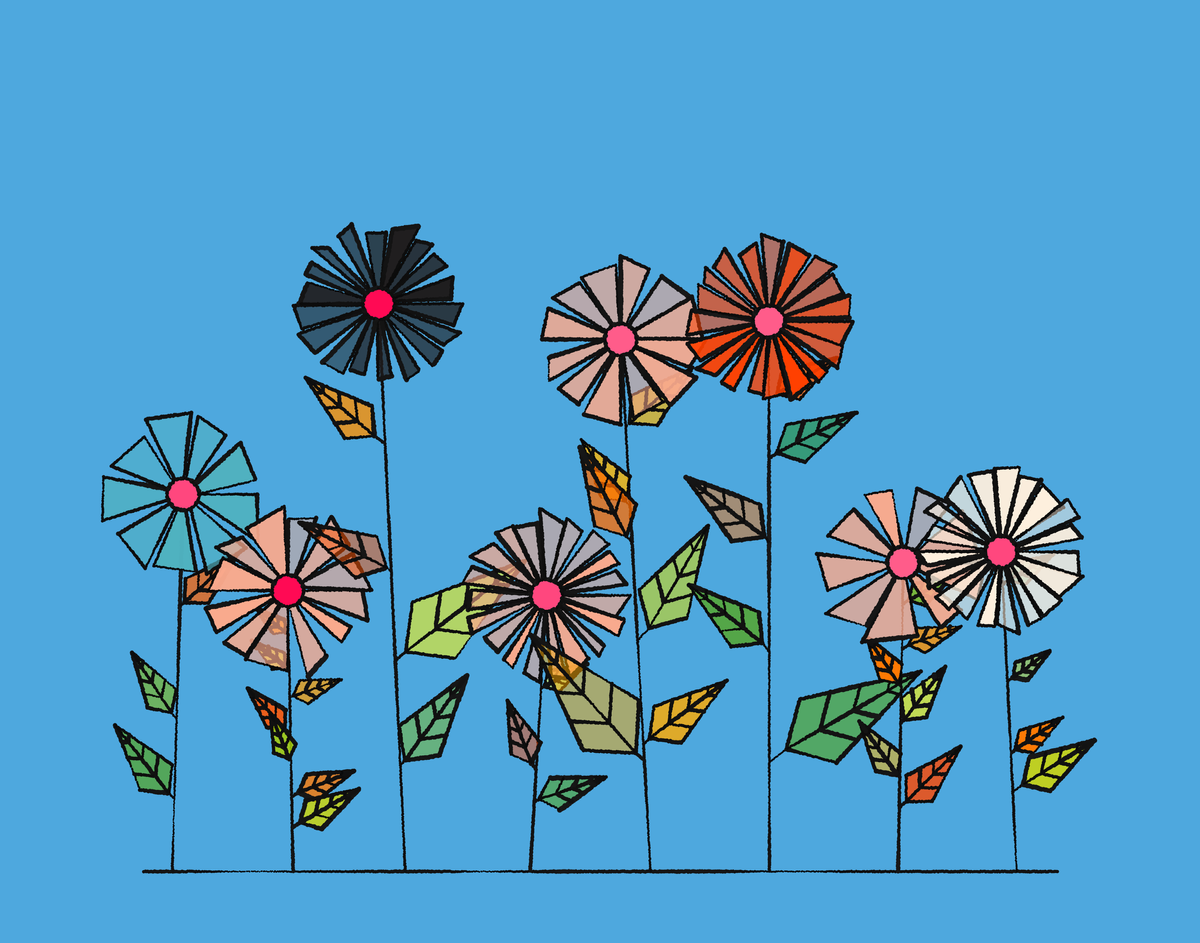Aaaaand — CUT! That's a wrap on another amazing Gorilla year! And how quickly it has gone by - it's a little surreal to find myself writing the yearly recap again so soon when it feels like I've written the 2022 recap only yesterday. And it's been yet another roller-coaster of a year, full of ups and downs, for me personally, for the Gorilla Sun Blog, as well as the generative art and creative coding space in general.
It's always crazy to see how far the blog's come in the short span of 3 years, it might not be very impressive when compared to other pages on the internet, but you have to keep in mind that everything on here is done by a single person - moi - and I'm incredibly proud of all the hard work that I've put into it so far.
It's definitely been a steep learning curve to this multifaceted endeavor of mine - from building and running a website, to writing various, vastly different kinds of content, to programming and implementing algorithmic ideas, to running a newsletter, and interviewing people, all while also trying to be an artist in some capacity, and marketing myself as such on social media; no single part of it is very straightforward and there's always several hoops that you need to jump through to get things done - it often feels like a big puzzle, where the goal is to figure out how all of these things should fall into place.
I know that I don't have to do all of these things - but I simply want to, it wouldn't be as exciting if I just did one thing and one thing only, I'd get bored very quickly, and I wouldn't have been able to stick with it for as long as I did. Since I've found such a wonderfully welcoming and supportive space, it would be a waste to not live out all of these passions of mine. It is genuinely incredibly rewarding to attempt all of these things and grow as a person. I want to thank everyone that reads my writings, on the blog as well as on other platforms, and appreciates my art, by collecting it or simply by leaving a like wherever I post my creations. All of these things only come to life and gain meaning through my audience - through you. So a big heartfelt thank you.
At this point, I believe that I've got a much better picture of how all these endeavors need to play into each other moving forward. When I initially made this website I wanted it to be a place on which I can share my creations and my writing, as I've always been very passionate about both of building things and documenting for others to learn from.
That said, let's roll the end credits for 2023 and recap all of the noteworthy Gorilla things that happened this year. There's been some big changes to the blog, many an article, a LOT of generative art, as well as many other creative endeavors and projects that I've been involved in. I'll also let you in on some of the things that've happened behind the scenes, and to wrap up, I'll also talk about my plans for the next year.
Let's get into the nitty gritty of it all to finish off this year, shall we?
The Blog in 2023
A significant chunk of my time this year has gone into writing again - I still think that it's one of the best mediums to convey information, and in many ways superior to video/audio formats. And that's a hill I'm willing to die on. I've published and written significantly more than I have in 2021 and 2022, even when you combine the numbers of both years.
Here's some rough numbers for 2023:
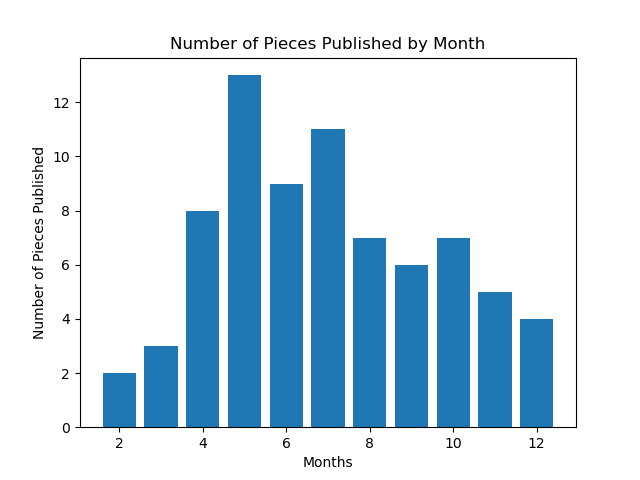

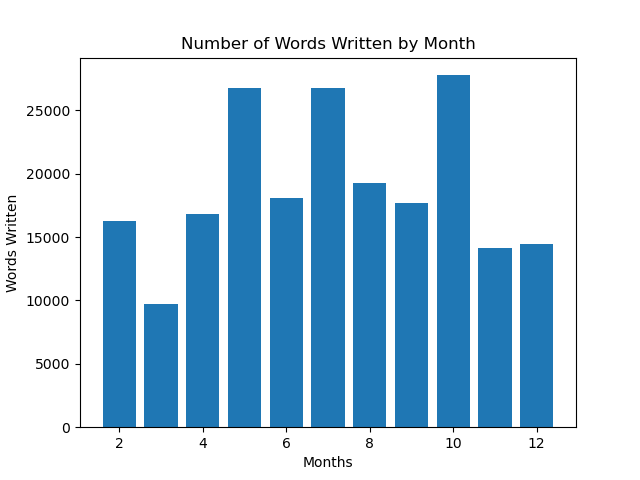
I aggregated these stats with my own webcrawler! I ended up writing a decent amount this year.
When I first started out in 2021, the main problem that I was facing was finding meaningful topics to write about - if you have a look at my earliest posts, they're all over the place since I was still trying to figure out what I actually wanted to write about.
In 2022 I then mainly focused on writing massive tutorials/solutions for certain timeless problems, such as computing collisions between polygonal shapes, different approaches for packing shapes in 2D space, the rounding of corners of pointy polygonal shapes, programming different types of grids and tessellations - all of them being non-trivial tasks in computational geometry, pursuing them mainly out of personal interest and for the lack of comprehensive and easy to digest resources on those topics.
I believe that these big articles are meaningful evergreen pieces of content, transcending generative art, and providing real educative value to those who need and/or want to learn about these techniques. I'm really proud of these articles because they provide simple solutions to hard problems. In the long run these types of resources also tend to be the best performing type of content on the blog:
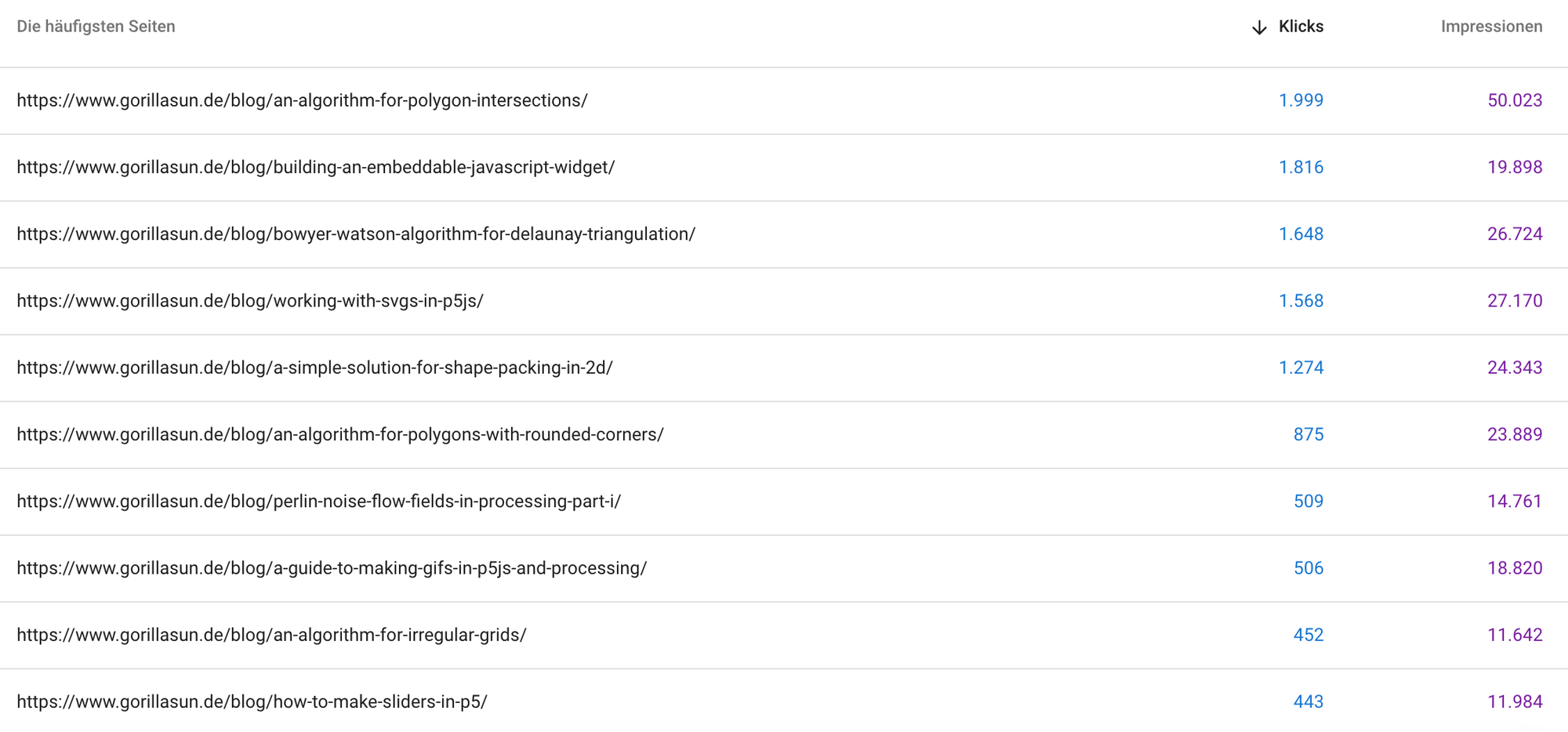
The drawback however, is that they take a significant investment of time and effort - from initially identifying an interesting problem, to finding a solution and then implementing it, as well as preparing demonstrations for each part of the process to actually putting down the ideas in written form - it can take days/weeks before you have a first rough draft for such an article.
In the current climate of the internet, that primarily cares about engagement, and the consistency thereof, this doesn't work very well. It's also frustrating on a personal level when you announce something that you've been working on for a while just for it to be overshadowed by something else the very next day.
For engagement purposes, and to signal social media algorithms as well as SEO metrics that my website isn't outright flat-lining, a recurring piece of content makes much more sense, but is at the same time hard to reconcile with the type of content that I've been making up until that point. That's why I tried a couple of new formats in 2023, in the quest for publishing more frequently, while also not bringing myself to the brink of burnout, and still providing value to the readers. We'll get into the details of this in the next couple of subsections.
Goodbye Jekyll
The biggest driving factor in turning the blog into more of a recurring publication was migrating to the Ghost CMS back in March:
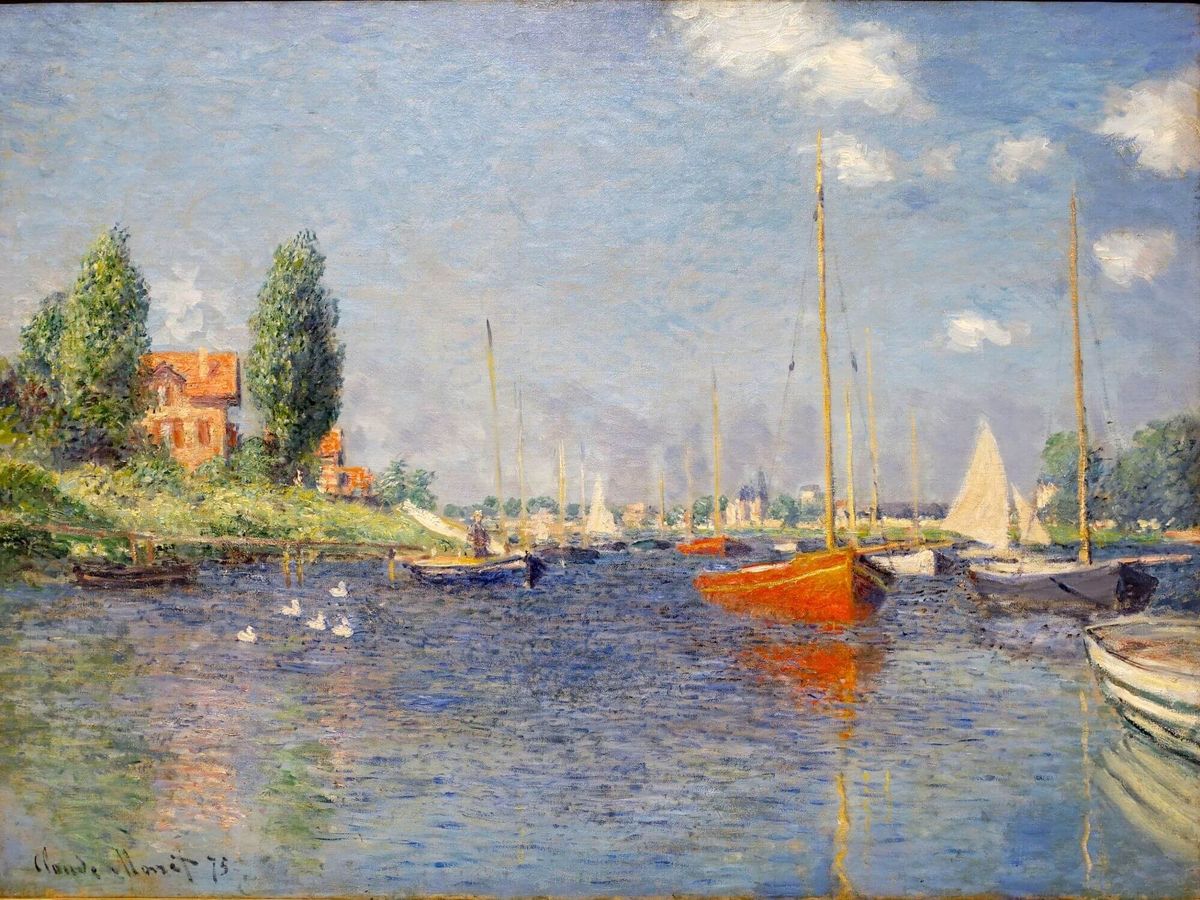
I wrote a little about this back in March in my post titled "Goodbye Jekyll" - which was also the very first email that I sent out!
Although Jekyll had served me well for almost two years, it quickly became very clunky to work with. It's actually a great blogging tool, which I'd probably still recommend today as a quick and easy solution for smaller blog projects. But as time went on, there were more and more reasons for me to move away from it and to find a more efficient tool that suited my needs.
The biggest reason for which I wouldn't advise using Jekyll today, is that the open source project is frozen and in "permanent-hiatus" - and chances are slim that this will change at any point in the future. A secondary reason is that you'll quickly run into Jekyll's limitations when you're trying to do anything custom that exceeds statically generated blogging content.
Moreover, my workflow became more and more tedious the more content I had created - Jekyll being a blogging tool, and not a content management system, doesn't help out with any of that. All of my markdown and media files lived inside of an increasingly bloated github repo, that was starting to take several minutes to rebuild whenever I made a minute change, like fixing a typo or adding a paragraph/image somewhere. Handling media files was also quite tedious, having to manually link to them in markdown to their corresponding location in the github repo.
That's why I needed a CMS to help out with that - after trying a couple of alternatives I came back around to checking out Ghost. I had only heard about it briefly before, but the more I looked into it, the more it became clear that it would solve many of the problems that I was facing. And I'm really, really glad that I took the leap so quickly and pulled the trigger back then - it took me roughly two weeks to move everything over, but it was absolutely worth doing so, saving me lots of work when compared to my workflow from back then.
Migration to Ghost
In a nutshell, Ghost is a CMS specifically designed for bloggers, journalists and content creators, providing a sleek interface and dashboard as well as a stellar editor in which you can write and create your content. At the same time, if you're savvy with web dev/desing things it's very flexible and customizable, letting you use and create your own custom themes, and routing your pages as you see fit.
When I decided to move over to Ghost, I modified one of the starter themes making the blog look a whole lot better than it did before:
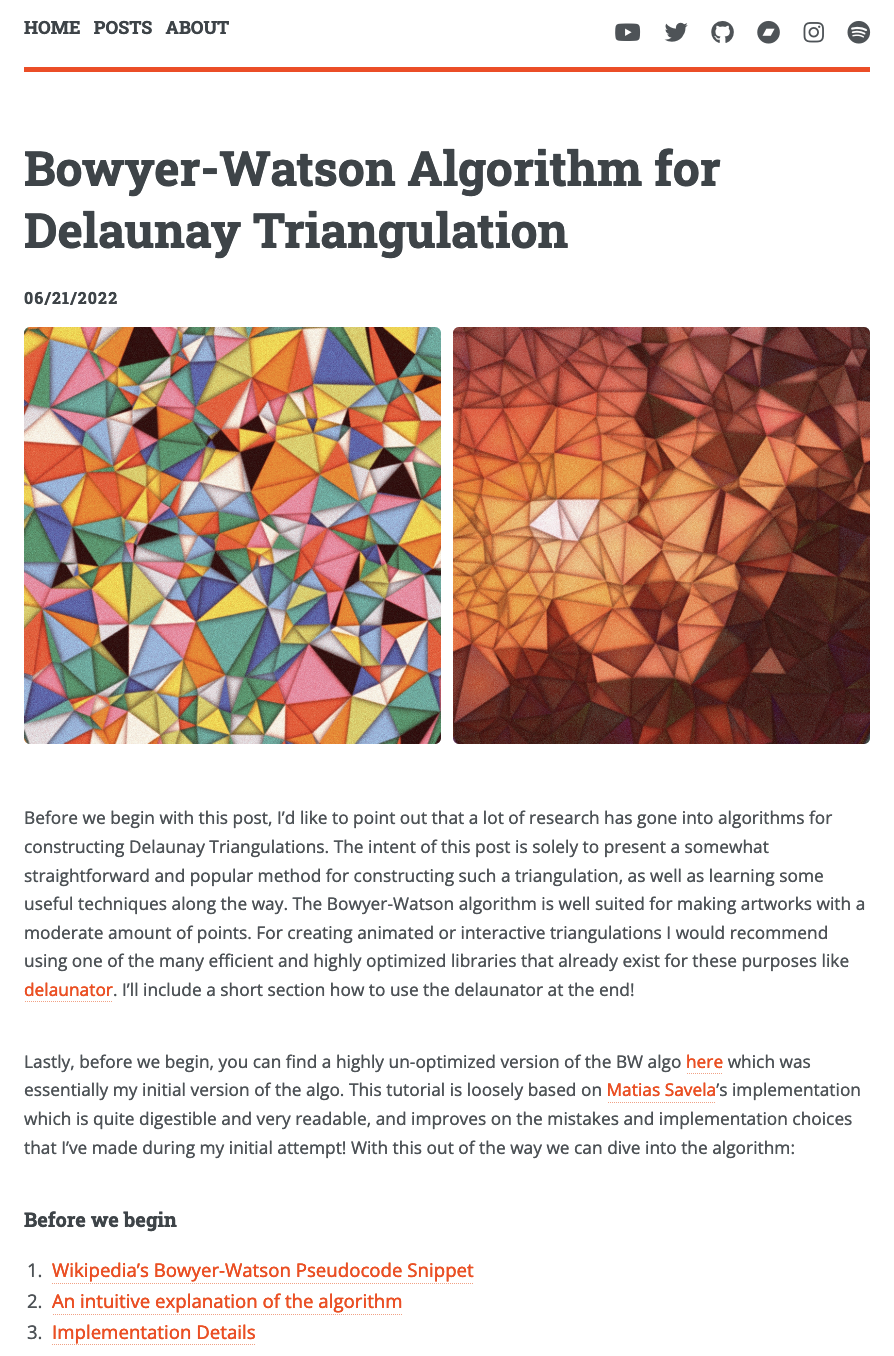
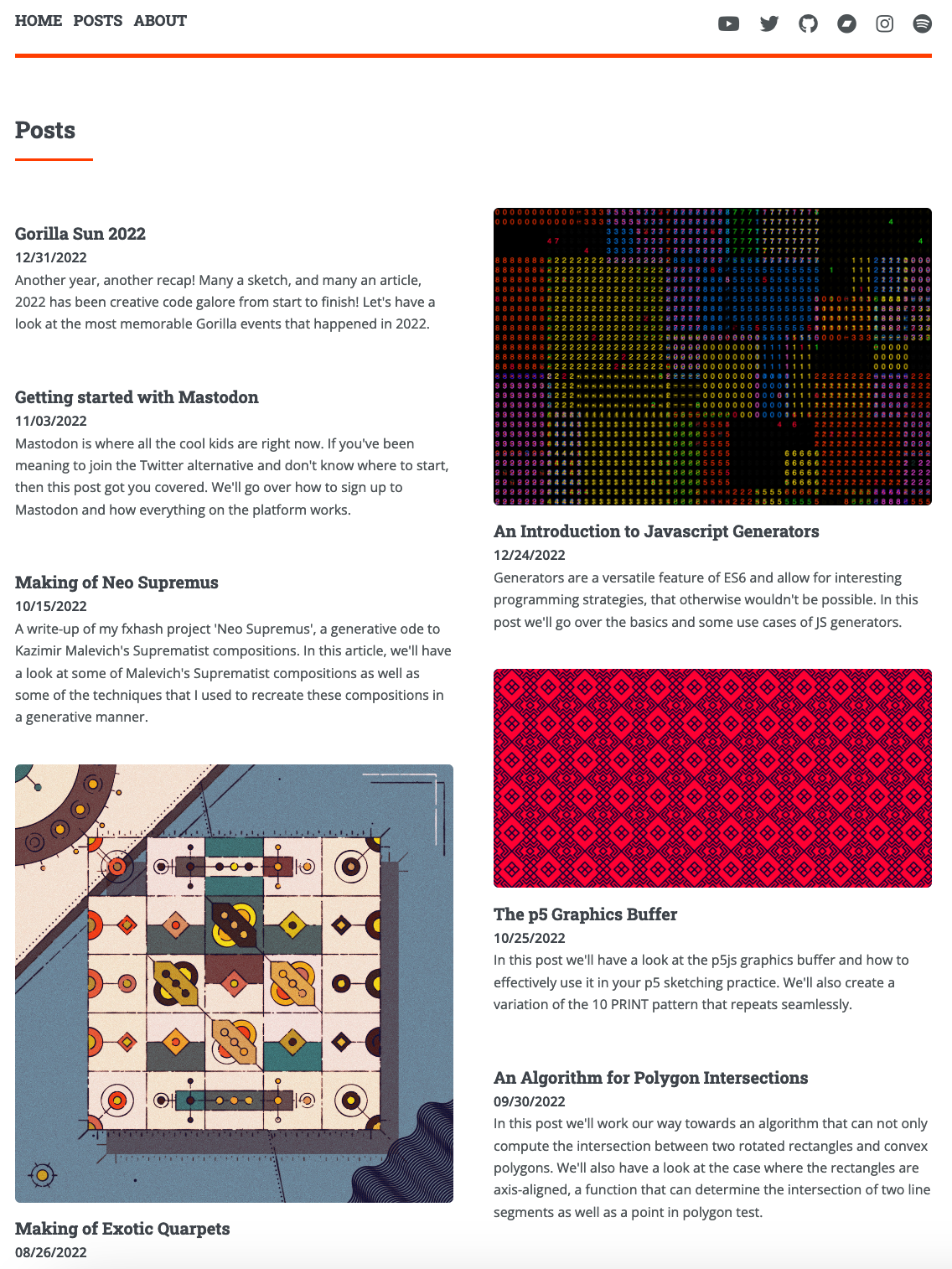
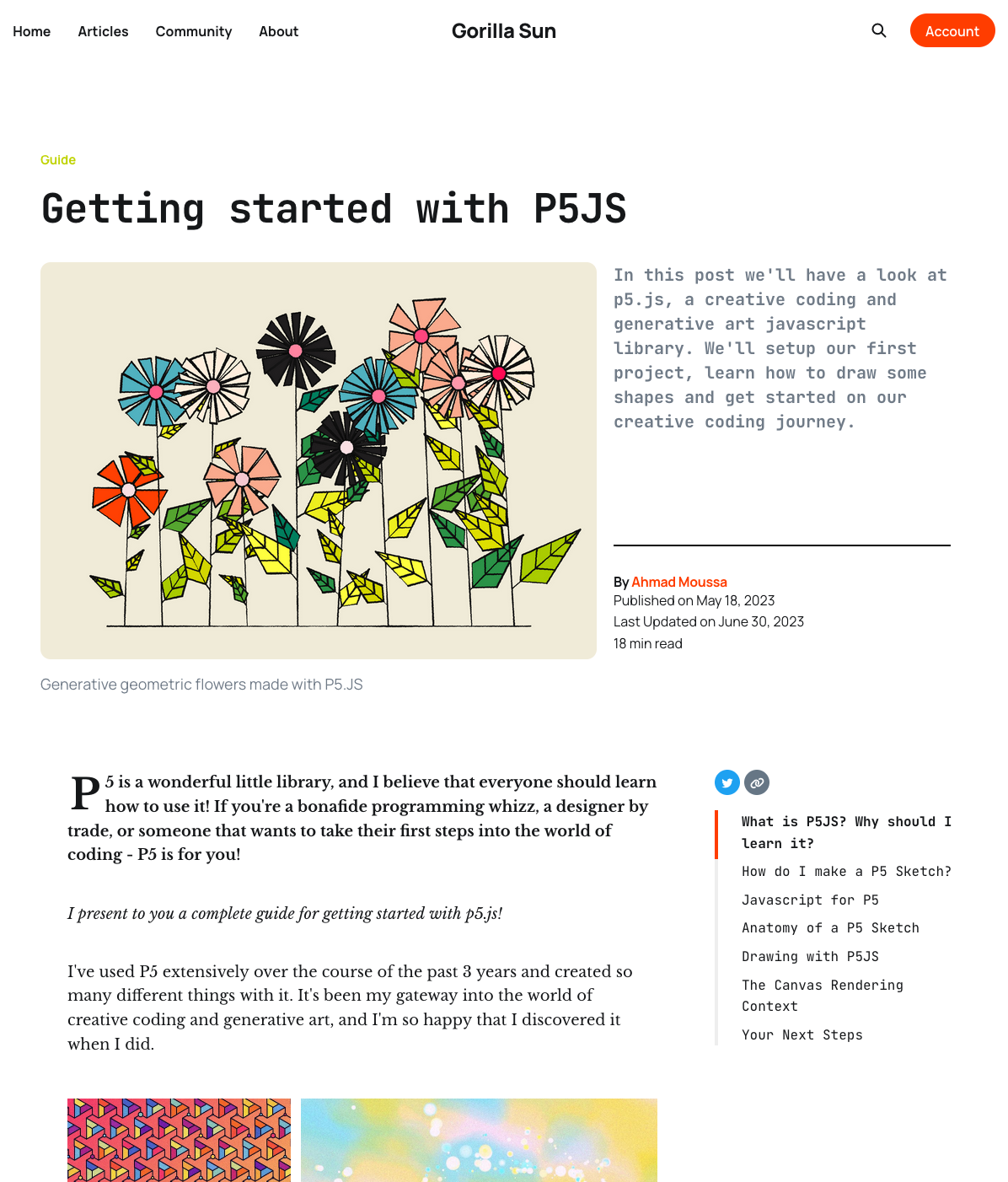
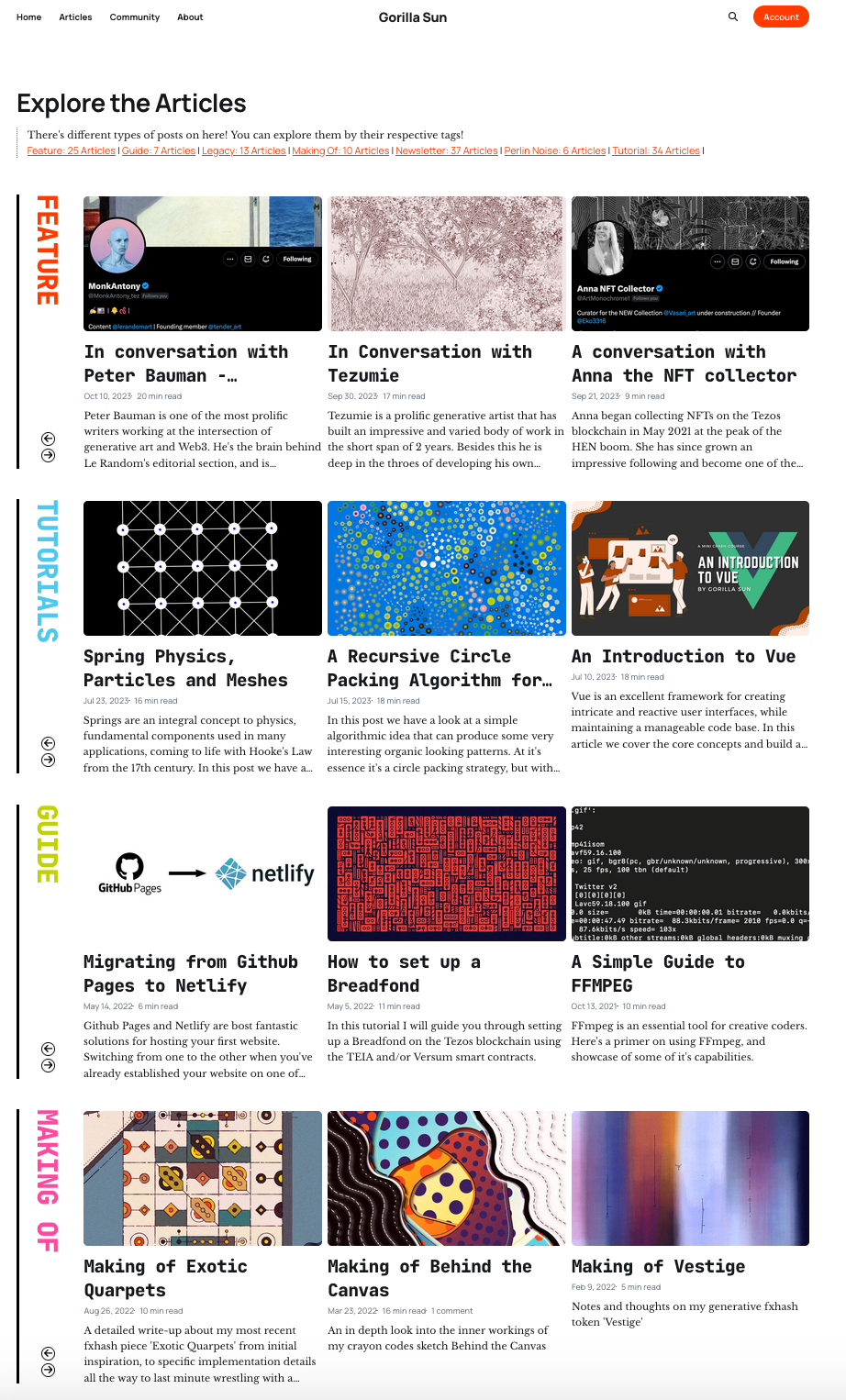
Old design on top, new design on the bottom. I think that the blog looks a lot better when compared to what it used to look like in the early days. The design is however not final yet and will undergo further changes in the future. All in service of the readership, to make it as easy as possible to read the content found on the blog.
Another reason in favor of Ghost, is that it's actively being developed, with several new features being released every month that simply make it a better and better tool as time goes on. For instance, you can now edit your images natively in the editor - cropping, rotating, annotating, etc... all of those shenanigans.

It still has its limitations, but you really have to dig deep to encounter those. Overall, it provides everything that you could possibly need to run a online publication. For the foreseeable future I'm definitely sticking with Ghost..
Disclaimer, I'm realizing that I'm gushing a bit too much about Ghost - I'm not sponsored by Ghost. In fact I pay for their pro plan that includes hosting - although self-hosting your own Ghost instance (on a digital ocean droplet for instance) is also perfectly viable solution, but entails more work and also isn't free. Their customer support is A+ btw.
Why am bringing all of this up? Because it's genuinely been a big part of my process this year, and I wouldn't have been able to put out as much work as I did without this tool. I feel like a lot more people should use Ghost - it's really great.
The Newsletter
One other really big thing about Ghost is that it makes it super easy to send out emails whenever you publish a new piece of content. Queue the Gorilla Newsletter.
Prior to that, I had a Mailchimp account set up for the purpose of collecting email addresses, but at the time I never actually ended up sending out any email. In hindsight I maybe should've - but at that point I was unaware of the importance of a mailing list for building an engaged audience - an audience that is untethered from your social media following. Hence, in search for a recurring format, having gained the ability to easily send out emails, while also understanding the importance of a mailing list; it all culminated in the creation of the Gorilla Newsletter.
In April I announced that I'd be publishing two pieces of content a week in addition to the newsletter - a tutorial on Thursdays and an Essay-like piece on Sundays. And well... that didn't go too well - I really struggled before ultimately dropping it as it wasn't doable, there was just not enough time for it.
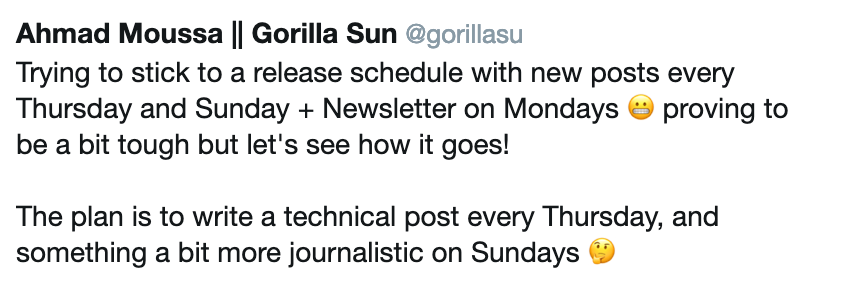
The newsletter on the other hand was much more tangible - the fixed structure makes it much more manageable from my end to publish it on a weekly basis. The initial pain point of What should I write about this time? solves itself by virtue of the content. But that's not to say that it's easier to write, you still have to do your research and due diligence to report facts and incidents correctly. So far however, nobody that's been mentioned in the newsletter has complained, so I guess I'm doing something right. Drawing from social media as my main source I assume that people are generally okay with having their stuff featured.
Here's a throwback to the very first issue of the Newsletter - it was quite rough around the edges:

The very first newsletter issue that I sent out on the 17th of April 2023. Feels crazy that I've been doing this for 37 weeks already!
There were other inspirations for the Newsletter though. Raph's weekly creative code news being one of them. Around the same time that I switched over to Ghost, Raph made the announcement that Creative Code News would be coming to an end, I thought that it would be a good moment in time to start my own version of it.
Partially, it was also something that I wanted to do for myself, in an effort to stay up-to-date with everything that was happening in the generative art and creative coding space - given that there's frequent period of time in which I'm honed in a on a particular project, letting happenings in the space pass me by. It then always feels difficult to emerge from these projects and to reconnect. I didn't want to feel like I was only doing things within my own bubble anymore, and have an active reason to keep up with developments in the space - committing to the newsletter gave me the best reason to do so.
With time it also became clear to me how fragmented conversations are on social media platforms, which is something that I started focusing on only recently, trying to provide a relatively complete picture of opinions on certain points of discussion that are floating around in the social media sphere.
Tutorials
Besides that there were also quite a few tutorials this year, one topic that I explored in depth were physics systems, how to program them and the different approaches to it:
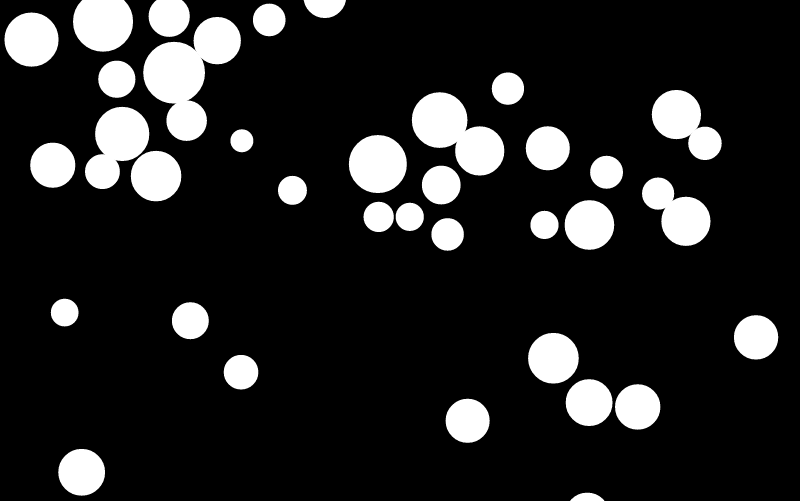
It actually ended up being a very intricate topic, which I would like to revisit in the future. Towards the end it was very interesting how a simple particle system can quickly turn into a soft-body physics simulation:
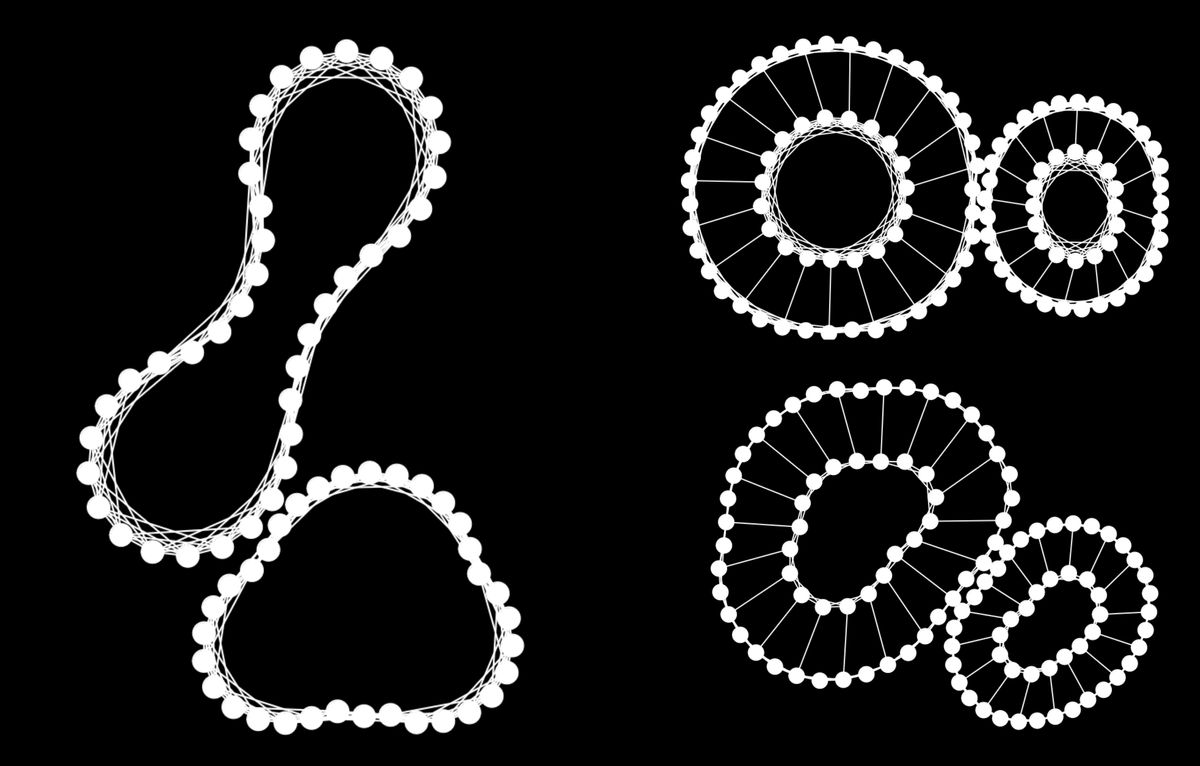
I also wrote about other things, like interesting organic cellular patterns that can be achieved with a recursive circle packing strategy:
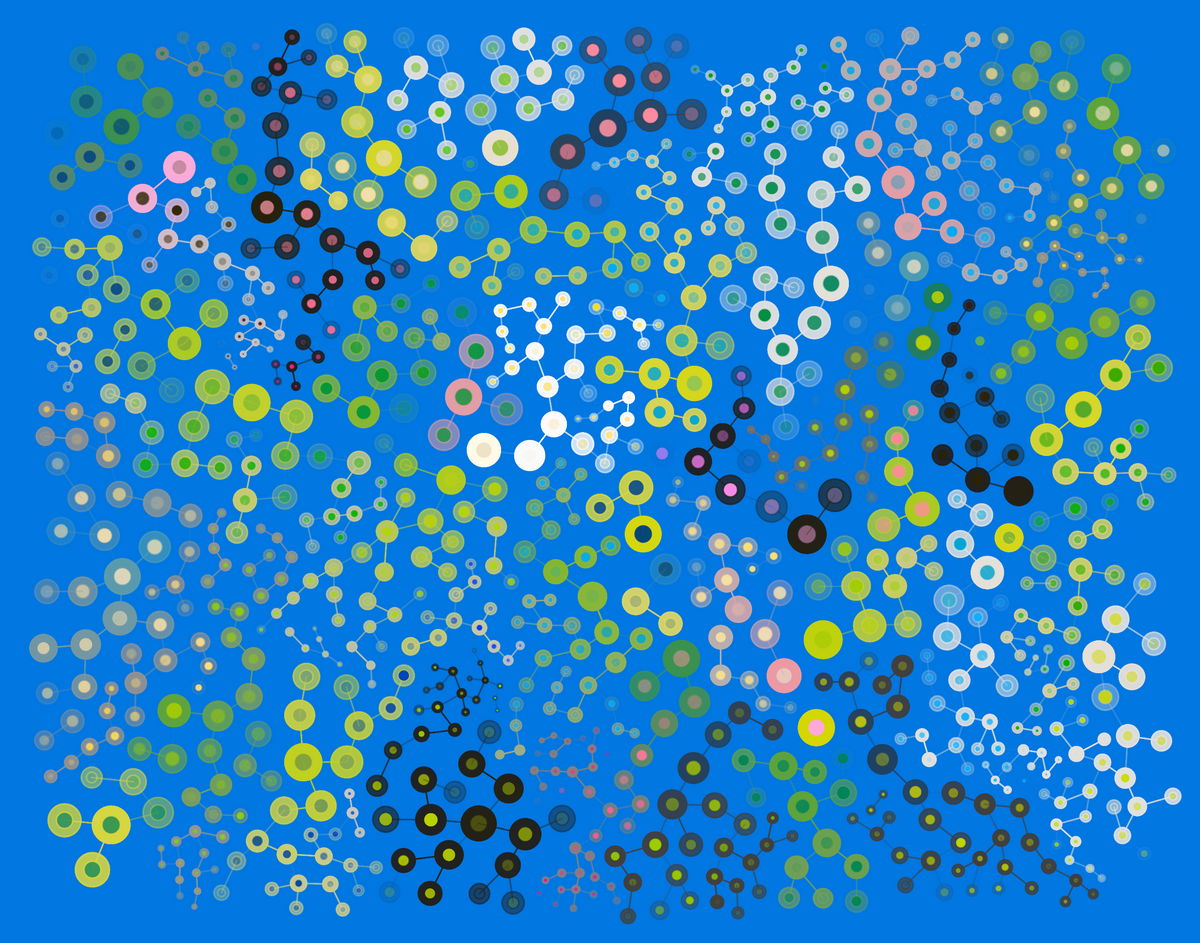
There were also a few guides which were way overdue, like an introductions to P5JS and all of the things that can be done with it.
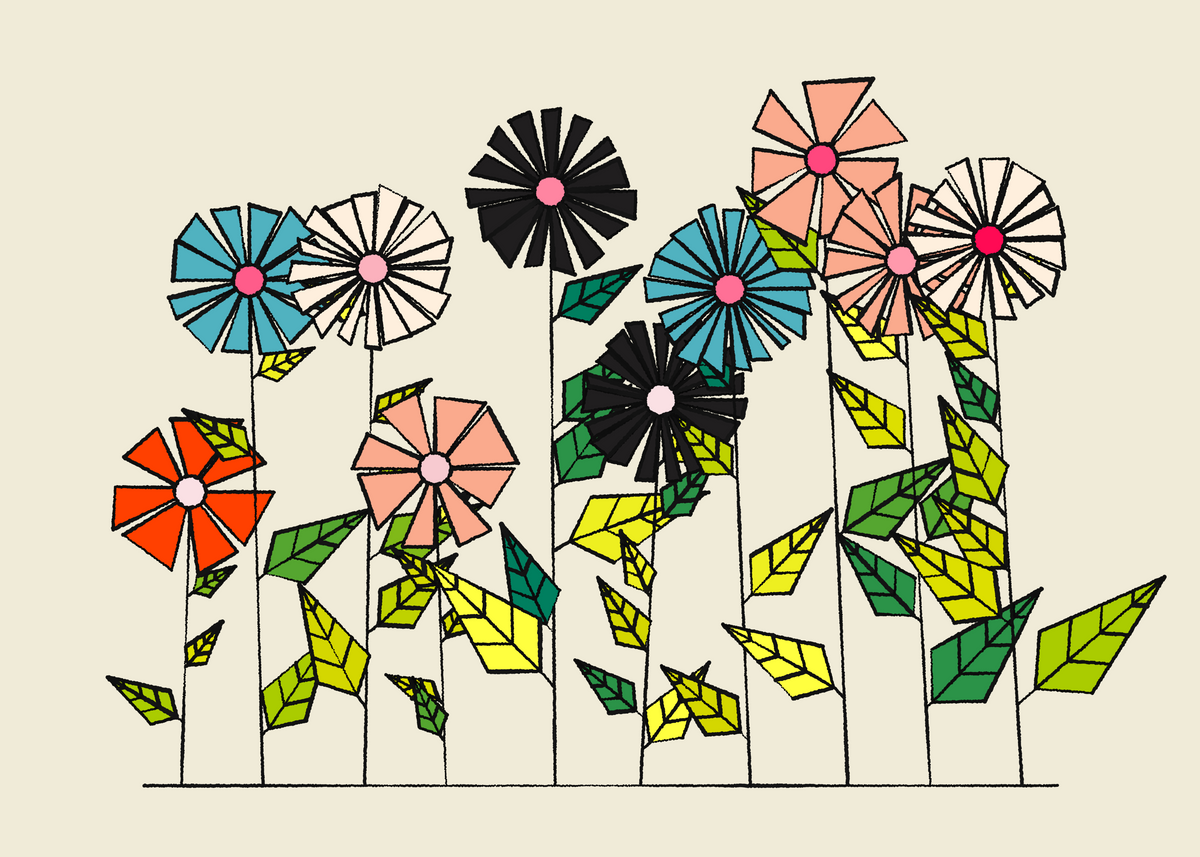
You can find all of these tutorials over on the articles page of the blog!
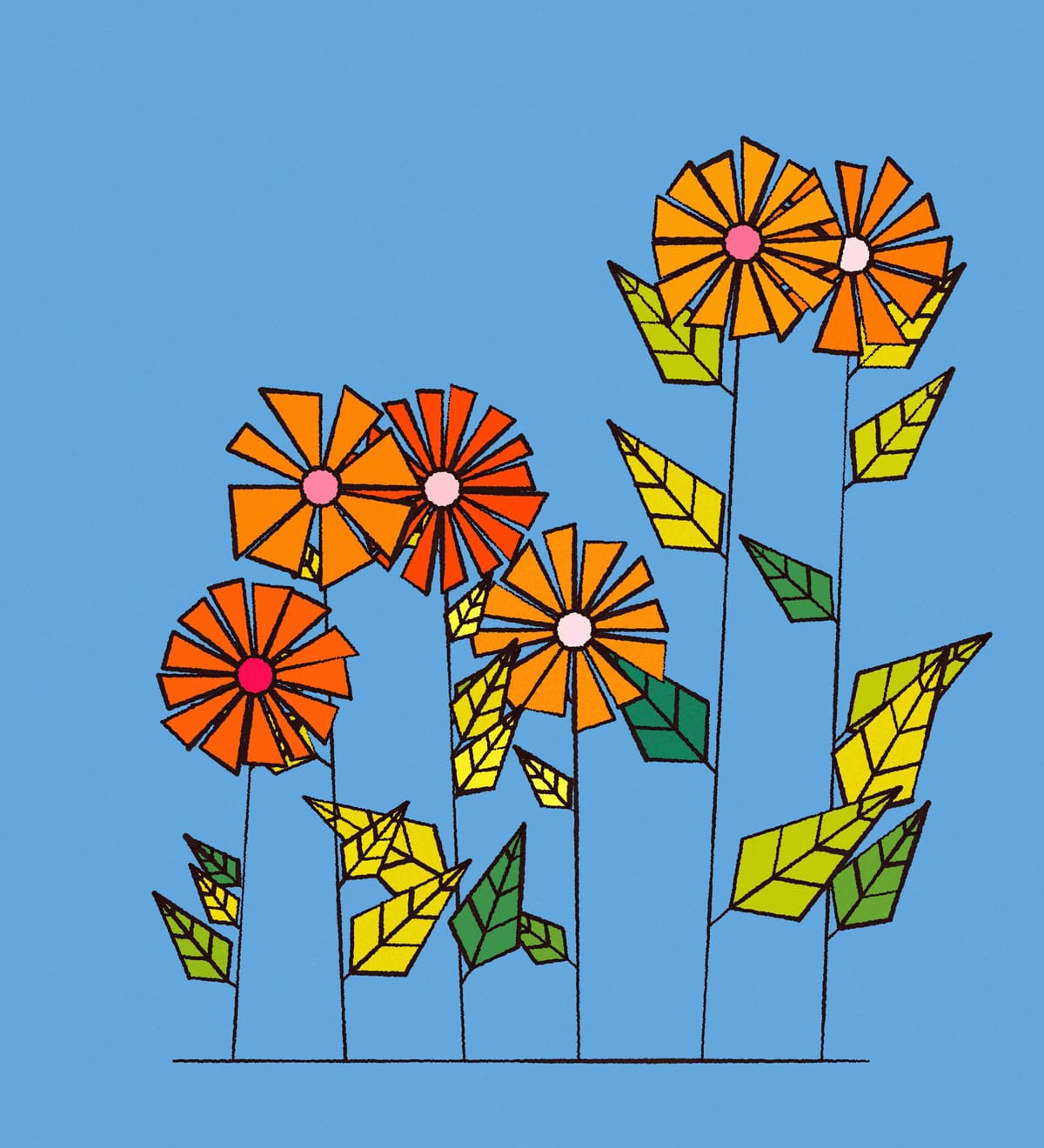
Towards Monetization
One other feature that I really wanted to have for the blog, was the ability to place posts and articles behind a subscription/paywall, in an ongoing endeavor to make the blog finance itself at some point in the future. Which was yet another reason for choosing Ghost as my CMS, which also allows for this. One initial solution that I found in that regard is memberspace, which is a tool that can be integrated into any website - but again, I would almost always prefer a native solution without having to manage things in a different location.
Another option that I considered, prior to checking out Ghost, was Substack which I actually gave a shot for a short period of time, bringing in all posts from my site using their import functionality, but there were quite a few issues to ir, since many of my pages had embeds and custom widgets that run code in them, which didn't import correctly. After exploring the platform a bit more and understanding how it worked, I came to the conclusion that it wouldn't work for my purposes.
All things considered, Substack is a stellar platform when it comes to running a newsletter/online publication, for building a community, as well as connecting with other creators. It provides all the tools to this end, and I'd say that it is superior to Ghost with its existing audience that uses the platform for the creation and consumption of content. But the drawback is that it is a very rigid and standardized platform when it comes to design and structure.
Not having complete control over the design of my pages, and the ability to add custom pages is really important to me. The Gorilla Sun blog is about generative art, and about building cool things with code, especially those things that run in the browser. Hence the blog needs to be artful and custom, to reflect this, and be capable of showcasing interesting things that run in the browser.
But to get back to the point, in the long run, doing all of this work for free is not sustainable, nor is it realistic - there have been very kind supporters that have donated via ko-fi in the past, which I am incredibly grateful for. But it would simply make much more sense to ask for direct support in exchange for "premium" type content, which would also greatly help in justifying all of the time that I spend on the blog and further build it out as an educative and journalistic platform/outlet.
One thing that I would like to do in the future, which is already in the works, is the creation of themed series of posts on certain programming and generative art topics - sort of like courses. Initially, the main goal would be to offset all of the fees associated with running the blog, such as the monthly hosting costs and the yearly domain registration fee.
Blog Roadmap for 2024
Now the million dollar question: where's the blog headed in 2024? There's a few things that are already underway, that fell off over the past couple of months because I had to prioritize other things in the meantime, but here's a rough plan for the coming year (at least the first half of it):
- Revamping the design of the Blog: the current design of the blog isn't optimal, for instance all of the main pages, like the landing page, the articles page, the about page - they all don't look very professional right now, and could really do with an overhaul. The main focus will however be the design of the content pages, I'd really like to have a custom design for each type of post, for instance a custom design for the Newsletter pages, for the Interviews, for the tutorials that often include interactive demos - and this will most likely take a significant amount of time to setup. The main difficulty of it being cleaning up the gigantic mess of a CSS file that's currently powering the design of the blog.
- Revision of the Content: the more content I push, the more typos and grammatical errors find their way into the writing. Additionally, there's many older posts that could do with a complete re-write, because they're simply not up to par any more.
- The Gorilla Explorer: I would also like to have a Portfolio page where visitors can explore all of my creations and artworks. I began working on this a couple of months ago, but I never managed to wrap it up, because it became more and more ambitious as I was developing, the main pain point being the amount of image files that need to be displayed. This is however something that I'm very excited to get my hands dirty with again!
- More Content, Tutorials, Interviews, Essays and Newsletters: I definitely want to keep pushing new tutorials and essays, which is becoming increasingly harder the more tasks there are that need to be taken care of, so the first couple of months in 2024 might be a bit slow while I hammer out all of the other things. There is however already a couple of new interviews in the works!
We're also quickly approaching the 3rd anniversary of the blog - I yet have to think about what I'll do for that occasion, ideally the new design would already be in place at that point. We'll have to see though.
Generative Art in 2023
I've made quite a few things this year again - overall I didn't spend as much time on coding as I did on writing, but I had many meaningful sessions in which I explored new ideas, concepts and algorithmic problems, discovering new branching paths to pursue and explore in 2024. Here's a brief recap of some of the pieces I did.
3 Group Shows
This year I had the chance of participating in a couple of group shows/curations, which were really awesome experiences - creating an artwork with a set deadline is a completely different beast to just leisurely taking your time and exploring ideas. Mid 2023 I was contacted by Haiver to participate in Alba's inaugural 'Flatlands' exhibition, for which I created my piece 'The Great Traversal', a piece that I had started working on back in November of 2022, finally bringing it to completion:
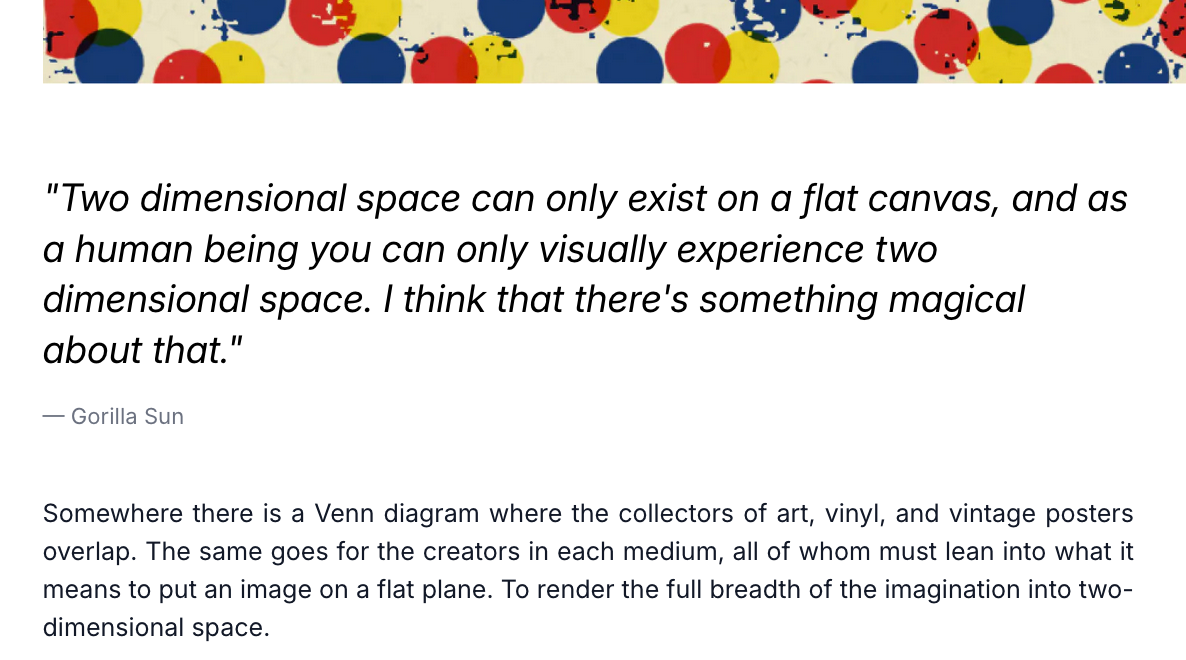
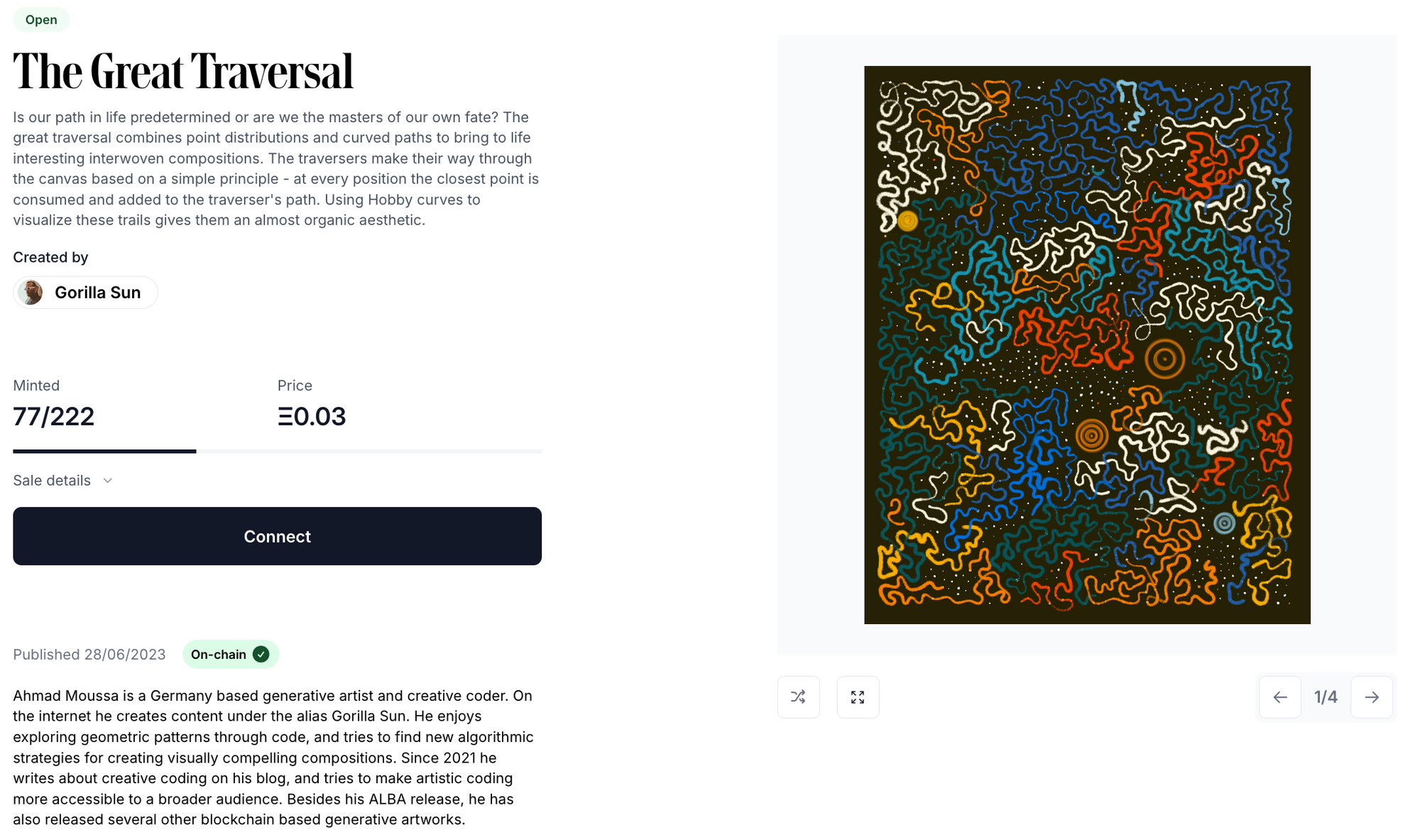
Later I applied for an open call put out by the Kumaleon people, which gave me the opportunity to participate in the Proof of X live minting show in Tokyo - here's a pic of the setup:
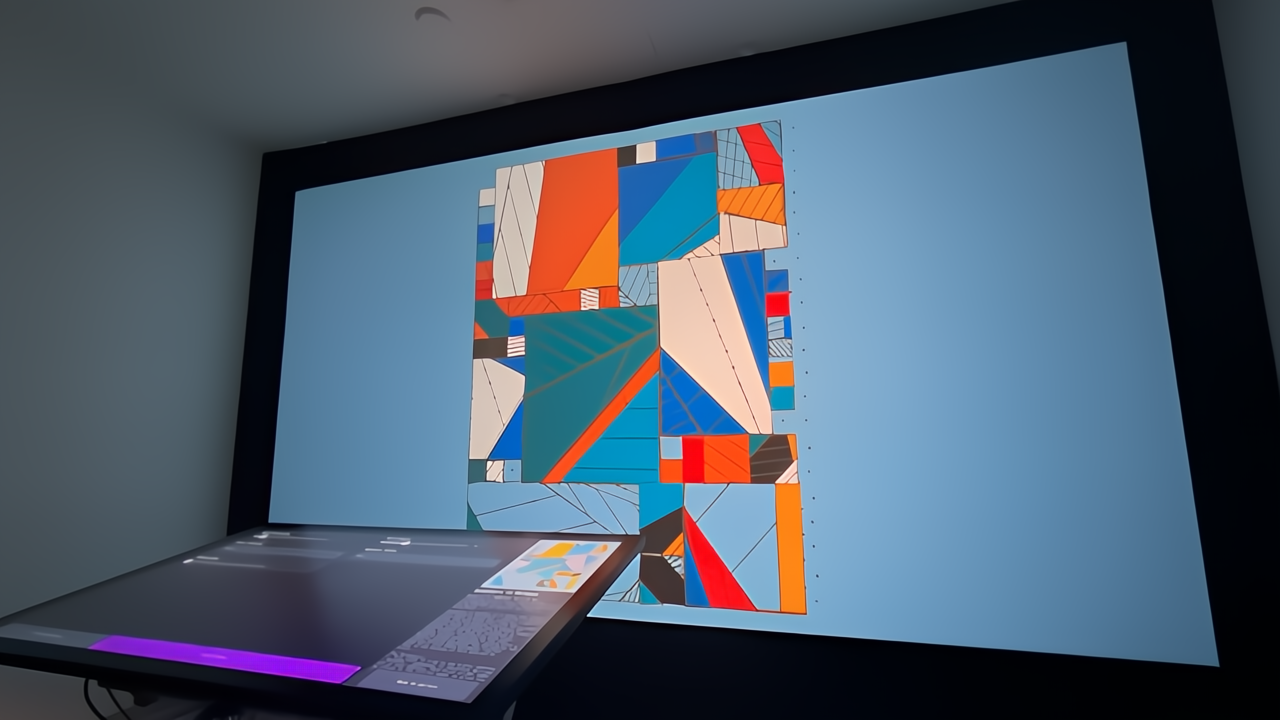

I also wrote a little more in depth about the project here.
Fast forward a couple of months, with another open call by KUMALEON x Okazz I had the chance to participate in their fxhash 2.0 launch curation titled 'Colorful' - I set out with an ambitious idea, and got a much needed extra two weeks to complete the piece when the launch was delayed:
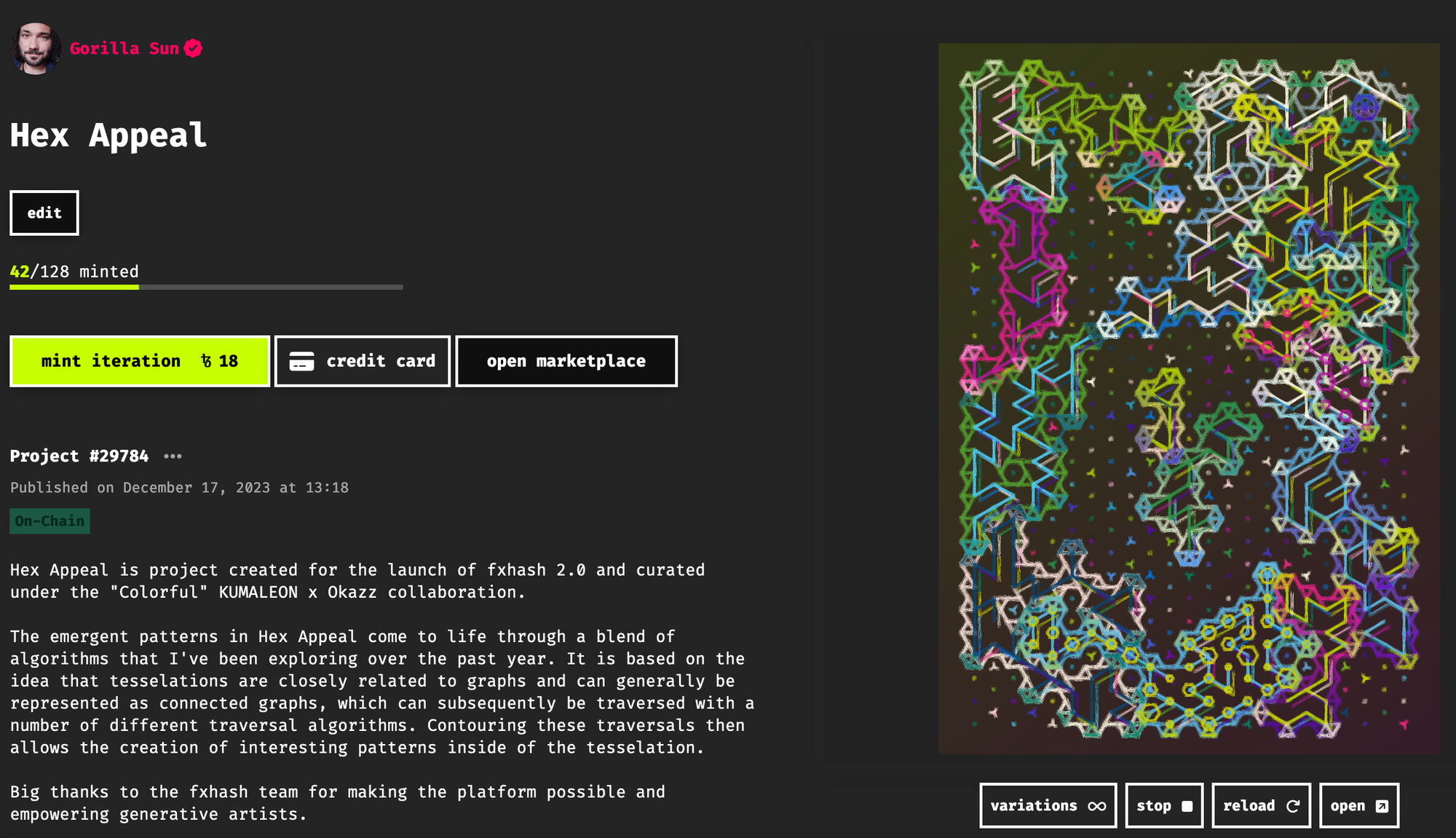
All three of these were incredible learning experiences, and I'm glad I got the chance to participate in them.
Here I have to mention how incredibly important it is to have a couple of projects in the pipeline at any given moment. People will at some point reach out to you, asking if you're interested in making a piece for this or that show/event, and when that happens you want to have something ready, even if it's just half-baked something, it's much much better to have a starting point than having to start from absolute zero. Moreover, it might also be a good idea to have some projects that are like 90% done for the occasions when a stellar offer comes your way with a tight deadline.
Lots of other Ideas and Algorithms
But the works I created for the group shows were only a fraction of the creations this year, here are a couple more in no particular order:
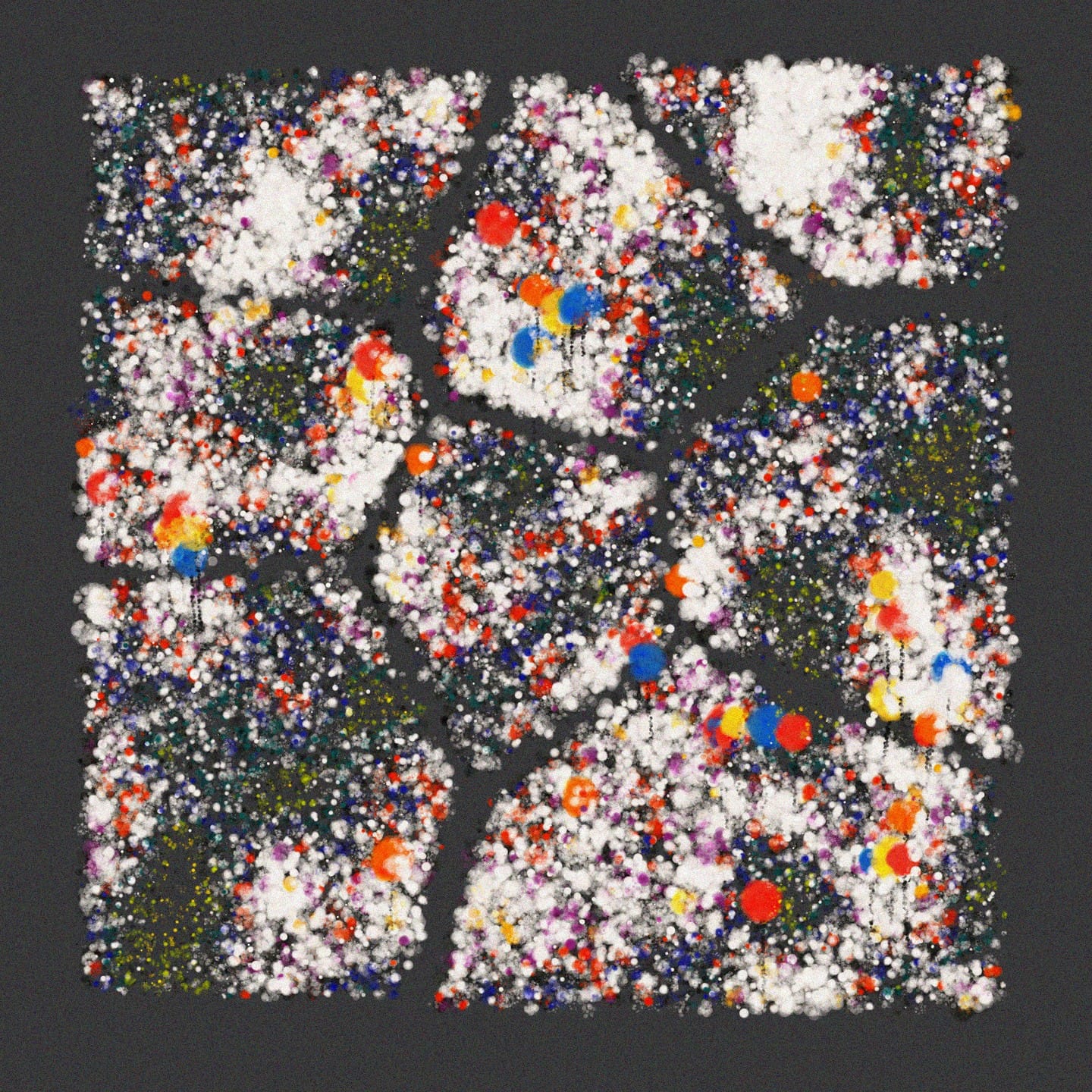
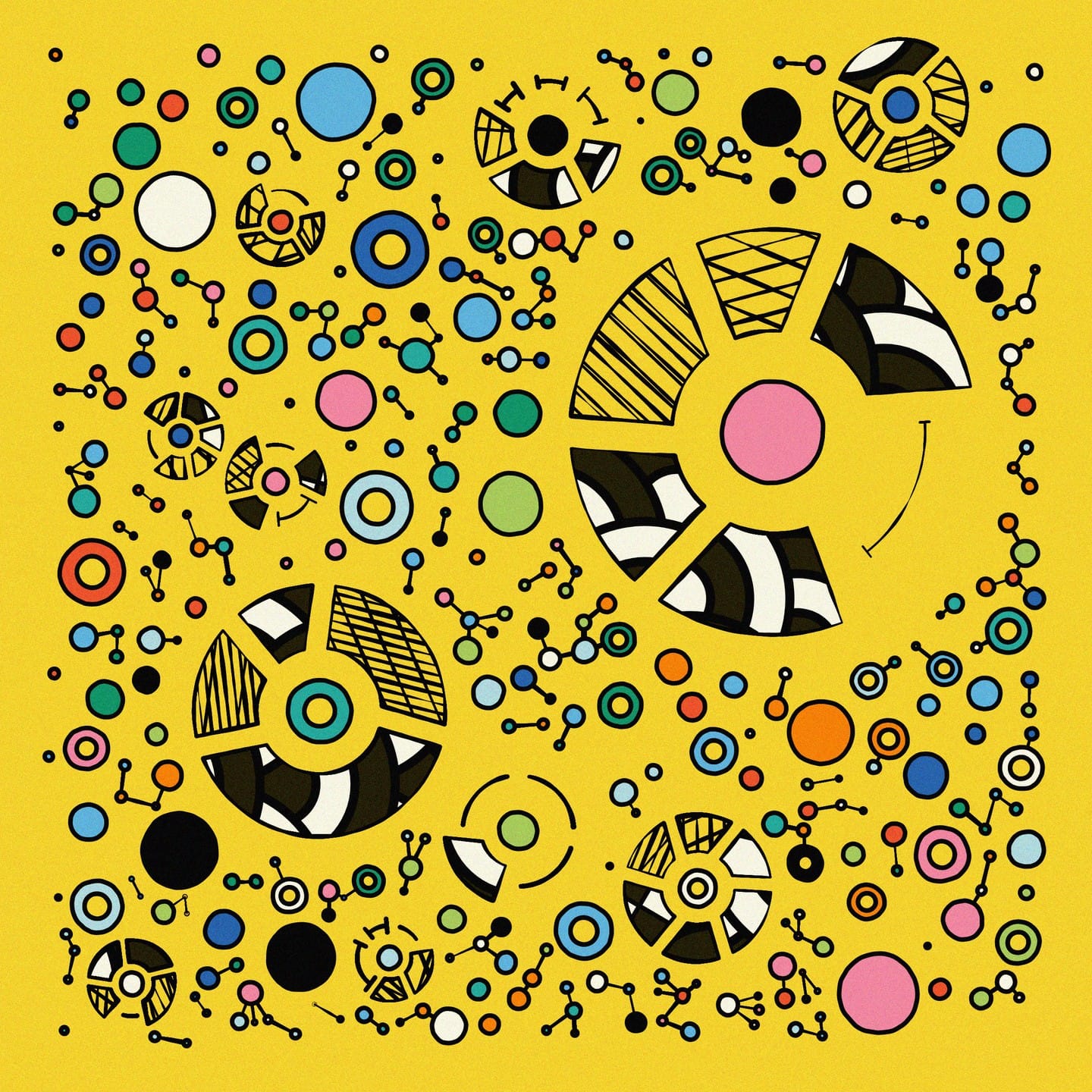
Some ideas that took shape in early 2023 during Genuary - during that period I was incredibly obsessed with circles and circle packings, trying to squeeze as much as possible from the simple technique. The right picture is another project on fxhash titled Assemblage - link to project page
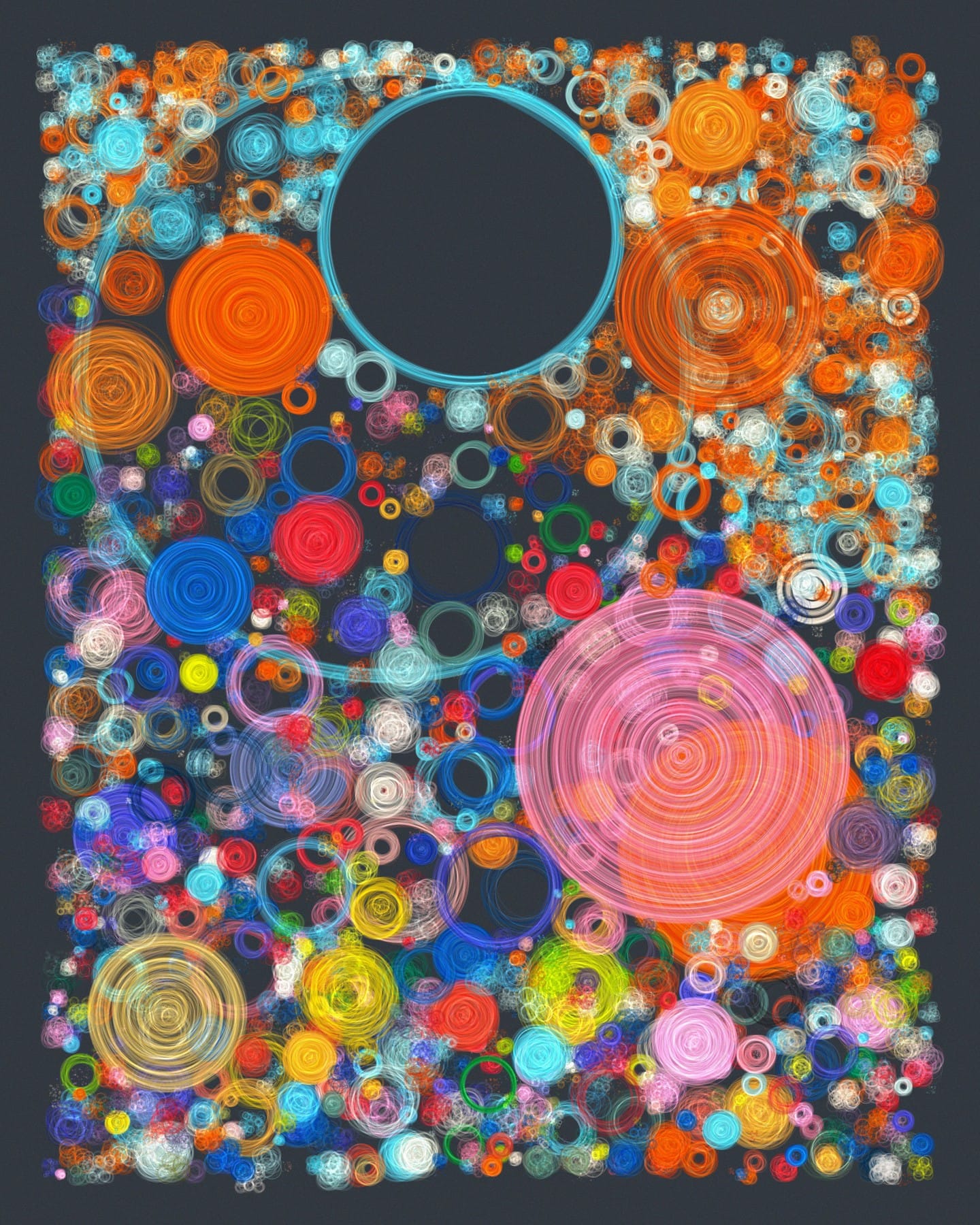
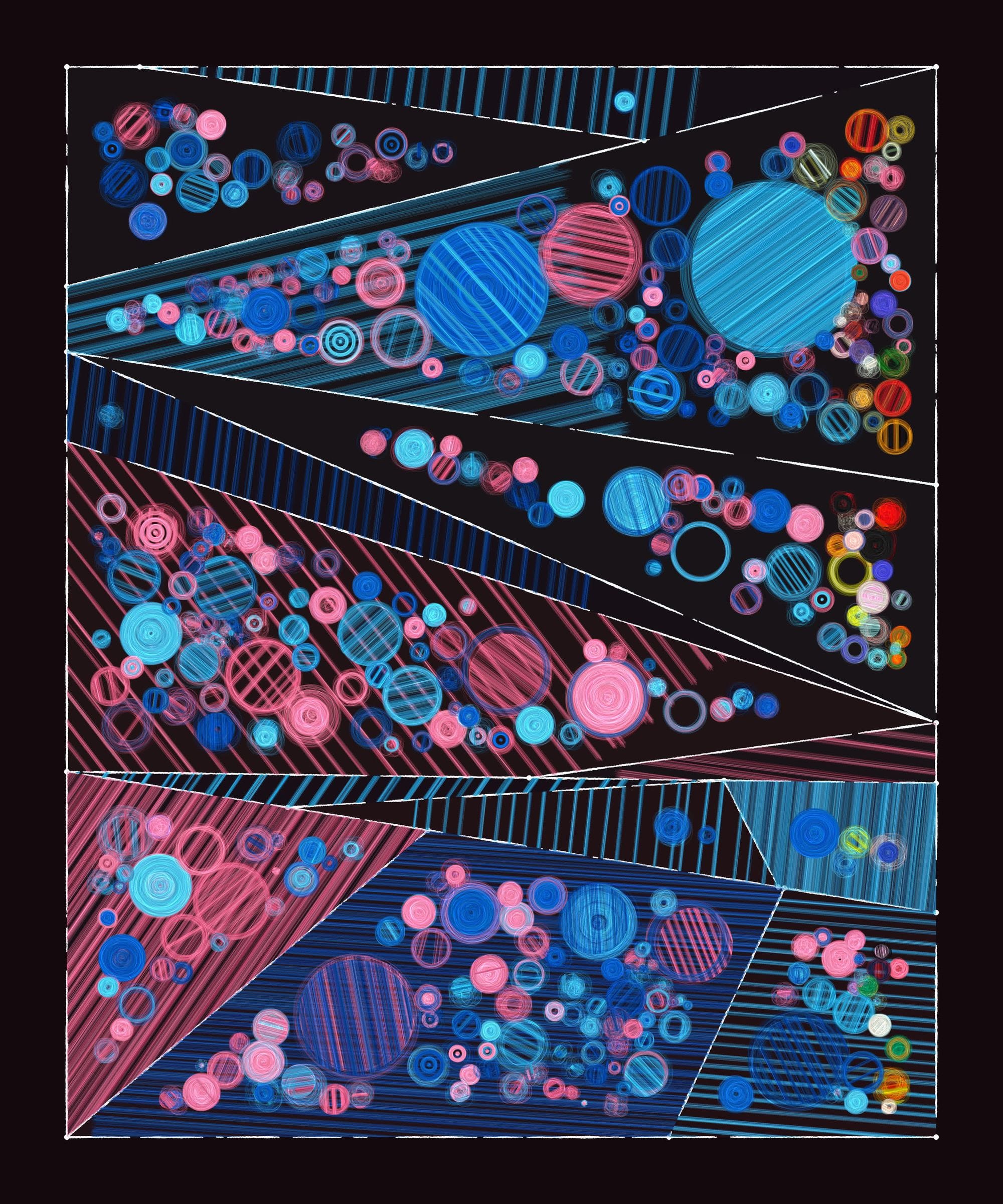
Sometimes there's also bigger projects that never get released. I worked on this heavily in February, but I never found the courage to put it out, although it is 95% done imo! It remains untitled as of today.

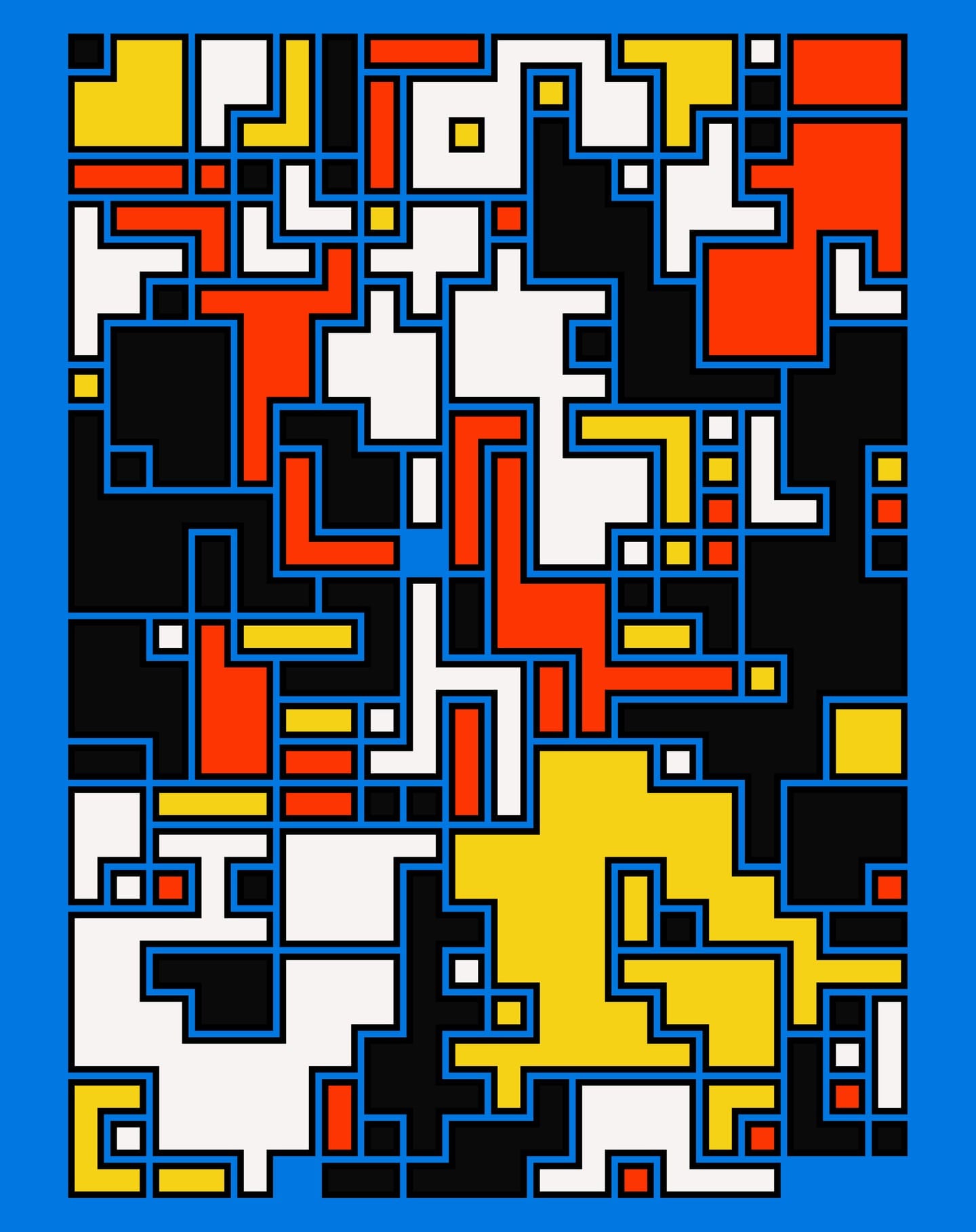
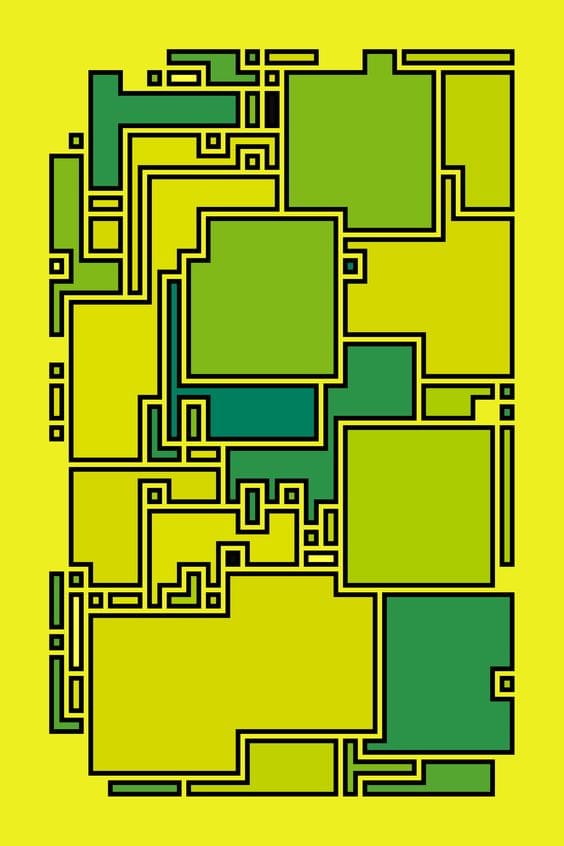
I also had an idea to extend my irregular grid algorithm - which I haven't documented yet because I haven't entirely explored it for myself at this point, but the patterns shown here emerged from a bug in my code. This also has nothing to do with graph algorithms.
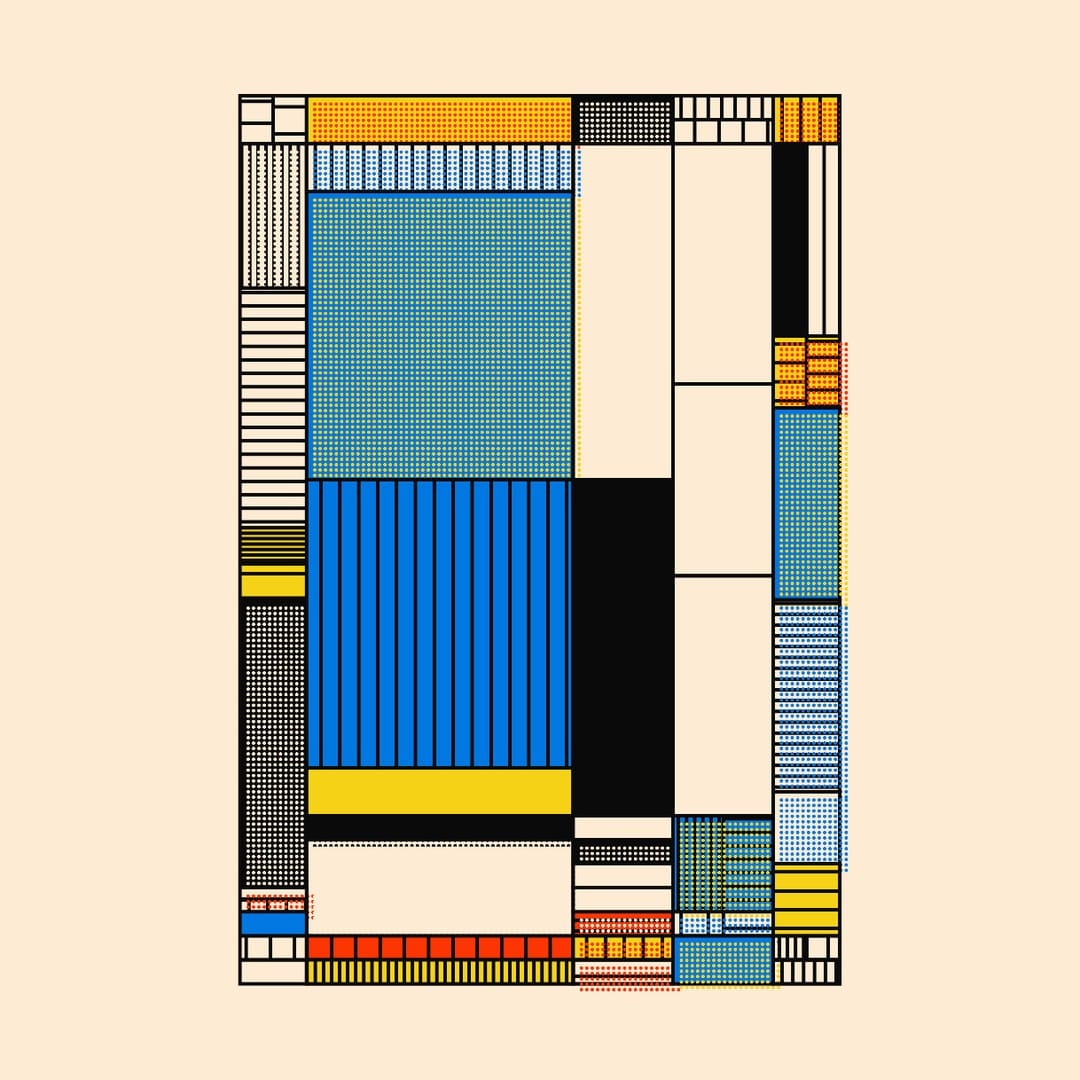
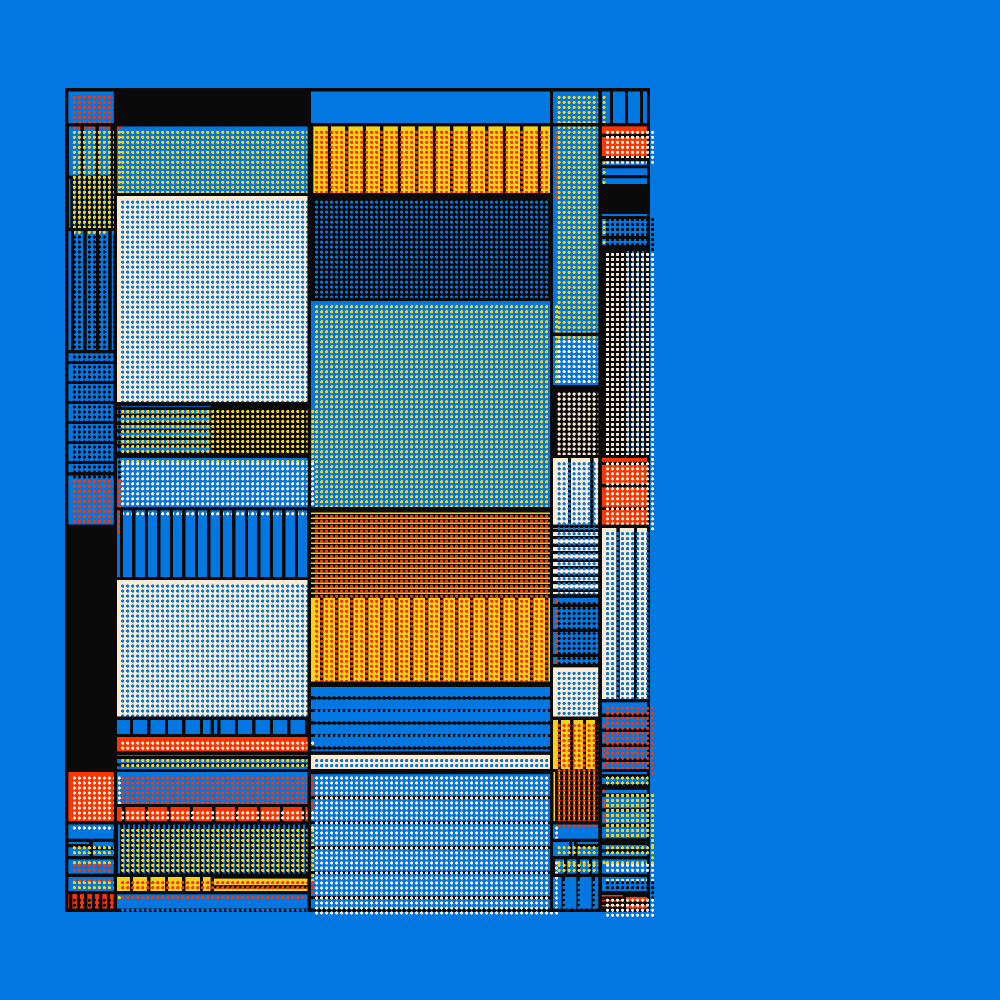
Blöck on EditArt.xyz - a very simple piece, whose reception really surprised me. It minted out in roughly about a day. Thanks to Piero aka pxfragile for putting together the lovely platform.
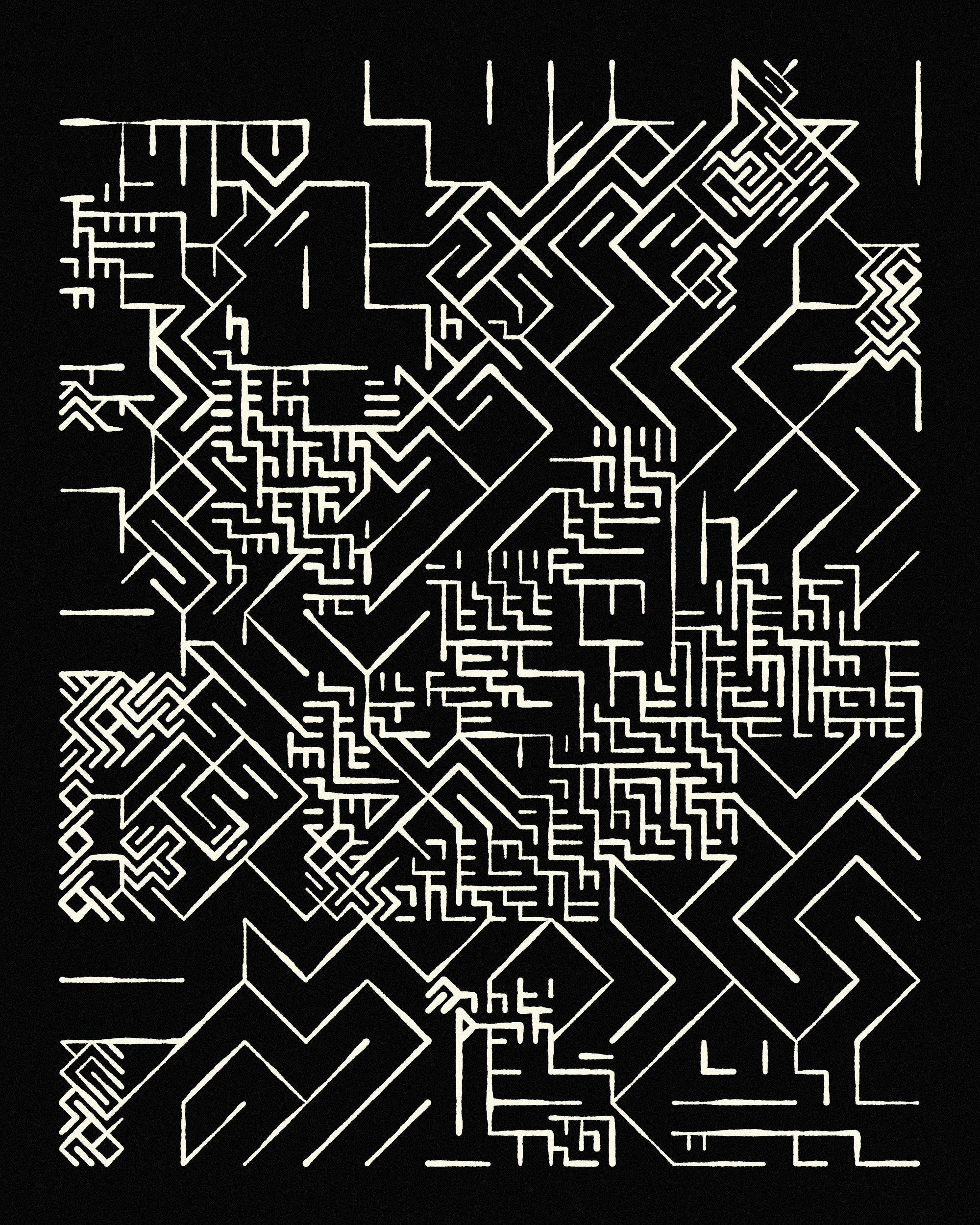
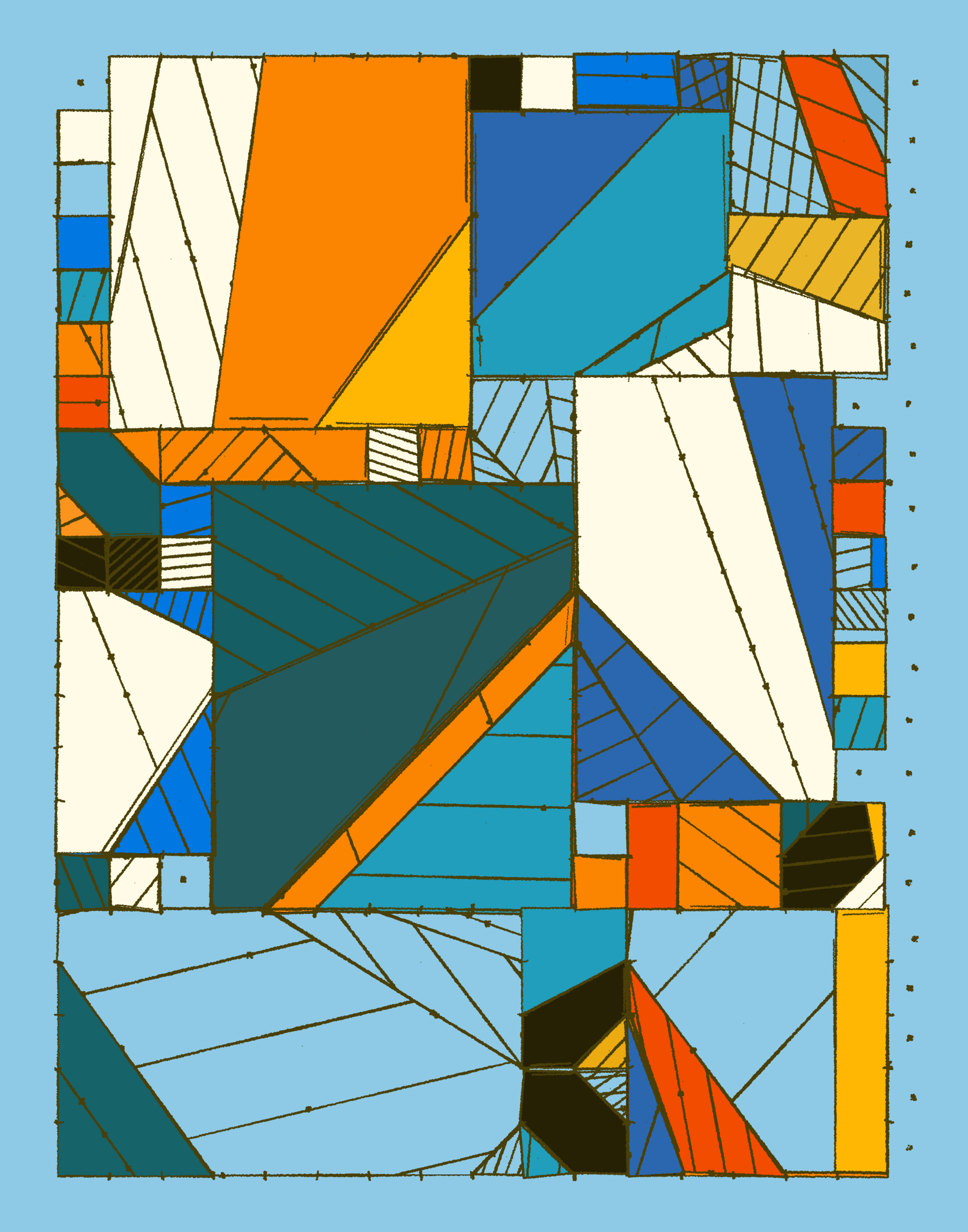
I also made quite a few fxhash tokens - Daze Maze on the left, my first forray into fx(params) shortly after the feature was released, and I think the first token that is WYSIWYG, as well as Somewhere in Between my project for Proof of X.
I also explored SDFs again as well - spirals on a rectangular grid being something that I hadn't explored before.
There's many more things I made, but I don't want to unnecessarily bloat this post with everything that I've made over the course of the year. That's what the Gorilla Explorer is going to be for, so keep your eyes peeled for it!
On Graph Algorithms
In the latter half of 2023 I mainly explored Graph algorithms, which I think is a relatively underused set of algorithms in generative art when compared to other methods like Perlin noise for instance - although the concepts and implementations thereof are not actually that complicated, here's some things I did with graph traversal shenanigans:
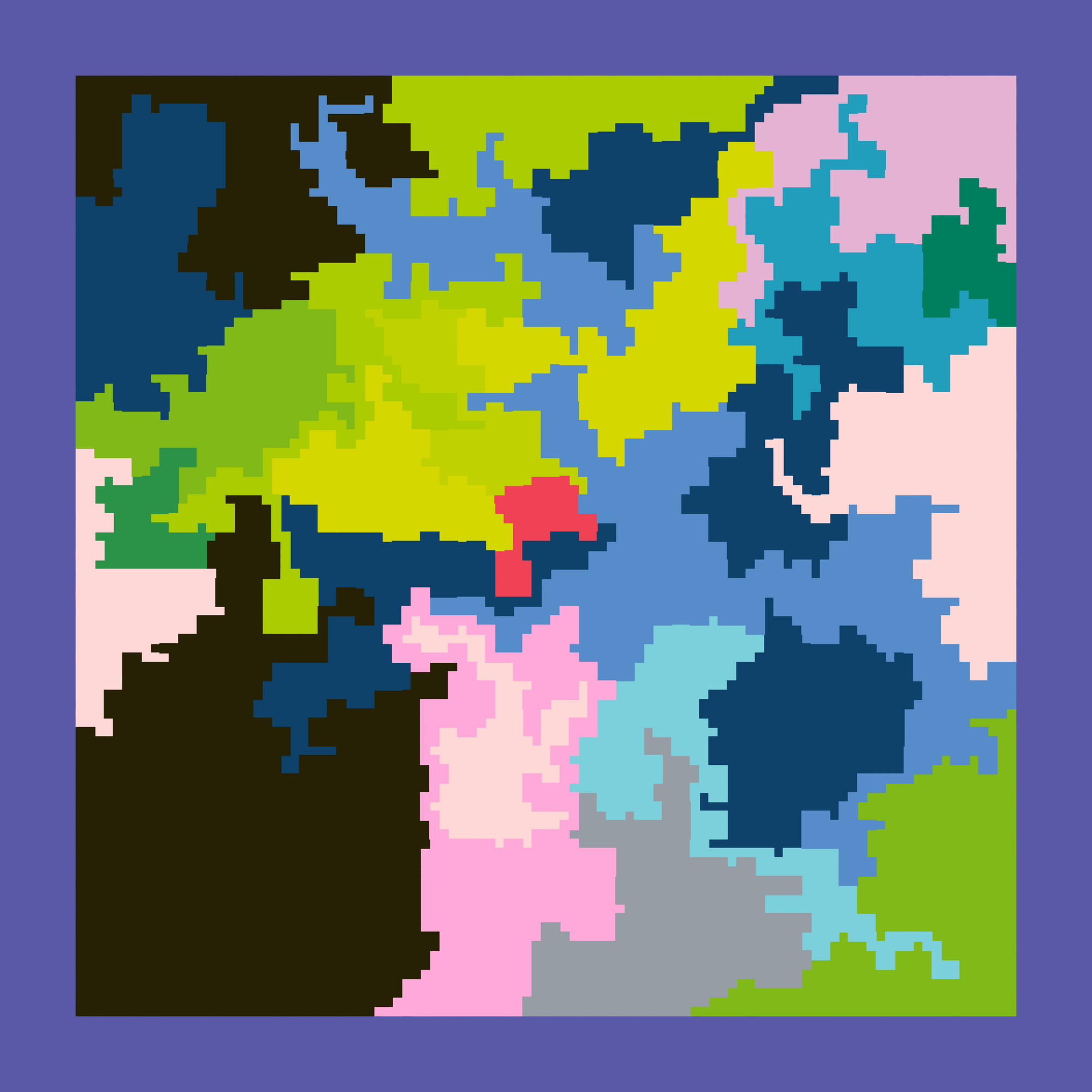
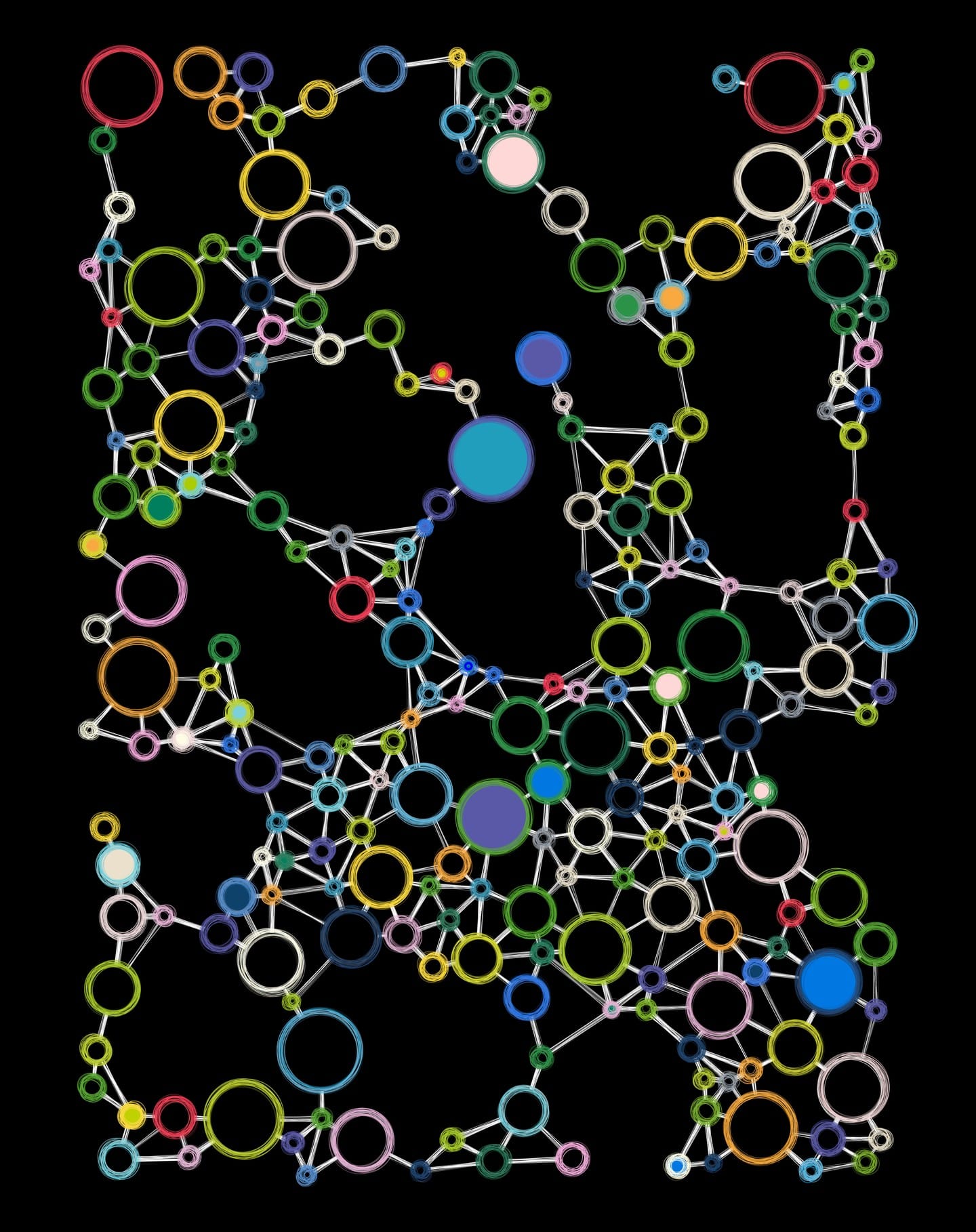
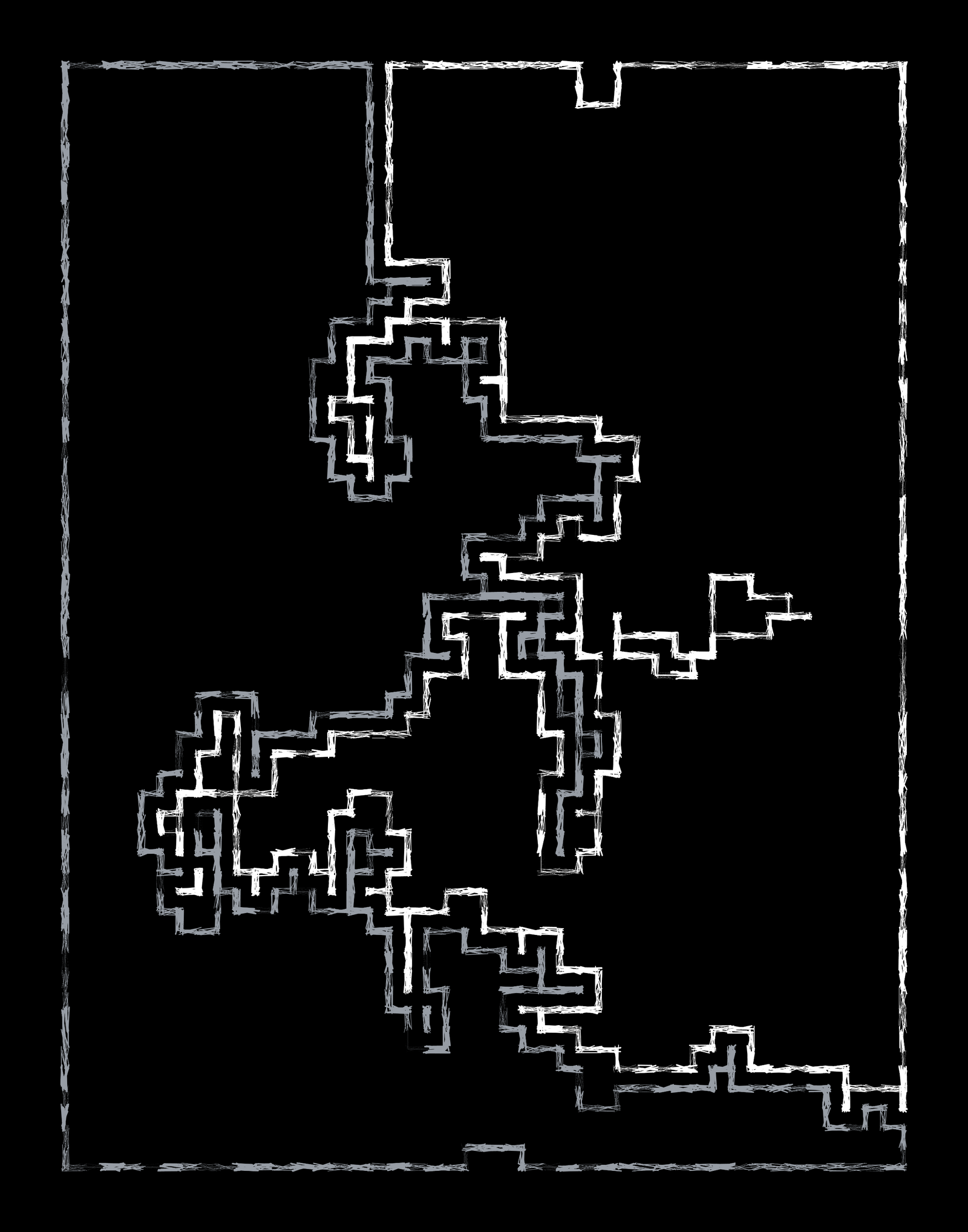
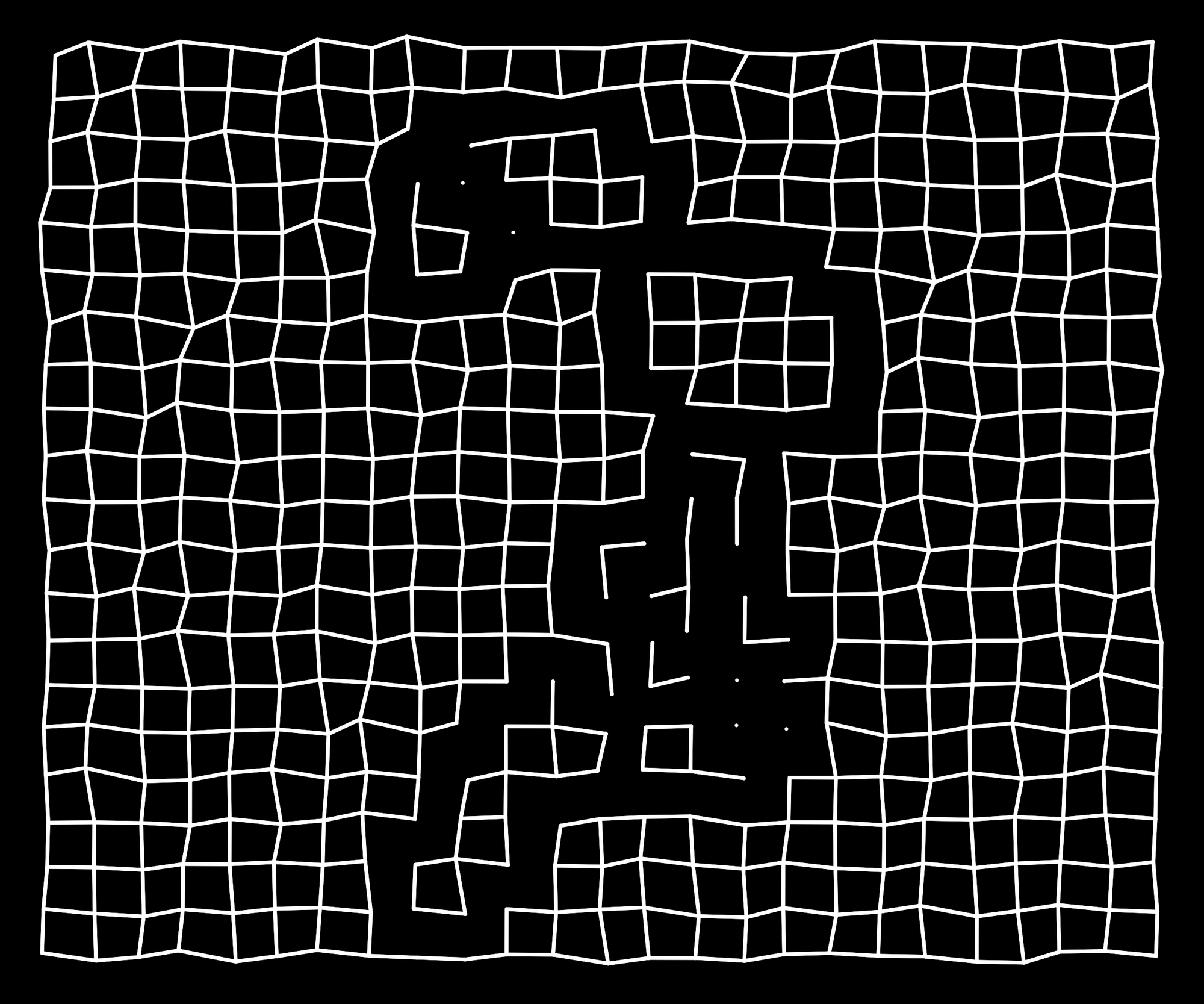
Here's Prim's algorithm in action used as a space filling technique, gradually populating a rectangular grid.
Especially in combination with tilings, that can be represented as adjacency graphs, this gives rise to many interesting patterns that might not be otherwise achievable. It's definitely going to be something that I'll pursue more in the future.
I think I will release a lot more art next year in comparison to what I did in 2023. I don't know why I didn't release that much art, in part I was heavily focused on the blog, trying to build up a decent backlog of content and finding a release schedule that works for me. Life has also been quite turbulent, looking back it feels like every day there's been something to take care of, completely unrelated to the blog and generative art. But such is life and everyone has to manage that somehow. When you have a clogged kitchen sink, it's not going to fix itself by posting about it on Twitter.
It's really important to be able to find back into the groove when other things are going on in your life.
Social Media
Once you decide to go solo and mainly start working on your own projects, be it coding, writing, or any other sort of individual endeavor, you end up spending a lot of time behind your workstation, by yourself. And you don't really have much reason to really talk or interact with people until you've actually completed the work. Which is in many ways counterproductive; the work that you are creating is ultimately intended to be seen and consumed by others - and if others have no connection to you or your work, or don't even know who your are, why would they then care about what you're doing once you decide to put your work out into the world?
It's undeniable that a strong social media presence and putting yourself out there is key in engaging with others, and signaling to others that you exist and creating work. I would definitely say that I'm not very good at it yet, it takes a significant amount of confidence and effort to post on a regular basis to the different social media platforms out there, which are additionally in a constant state of change as it seems . But if you want to get the word out, you have to be loud.
One of my personal goals in 2024 is to put myself out there even more, posting more regularly, while also not worrying too much about what others might think about the things that I'm posting - over on Twitter I've currently got a little over 8k followers, which is a sizeable audience, and I'm incredibly grateful for everyone that thought it's worth following me and keeping up with the things that I do, but there's also some pressure that comes with it when you know that your postings will be seen by so many people. I generally don't want to unnecessarily waste anyone's time with posts that don't have anything interesting to say or show. Hoping to be more relaxed about it though in 2024.
My best performing post in 2023 was actually something that I did for the second Genuary prompt "Made in 10 minutes", for which I simply recorded a timelapse of myself live-coding a piece from start to finish. I didn't really think too much about it prior to posting it to Twitter, I simply thought that it would be a cool thing to do - but it ended being something that people really thoroughly enjoyed - I think that being able to see the entire process at once is very satisfying, also seeing the different stages that the artwork goes through and how the code comes to life:
Maybe I should after actually try and put in place a social media strategy for myself - I think there's a lot of things that I've coded and written at this point that would be worth sharing again in a revamped format.
People and Projects in 2023
Although social media can go a long way, there's nothing that beats getting to know someone face-to-face - either in person, or via a video chat - having a conversation is after all the most human way of communicating and exchanging ideas.
Interviews
First off, I'd like to give a big thanks to all of the people that have agreed to give me a significant chunk of their time and have had a chat with me for the blog: Anna, Tezumie, Monk, pxlshrd, whitecross, and Nerios - thank you so much. These conversations have been incredibly rewarding and enriching experiences, exchanging ideas face-to-face and connecting over shared topics of interest is always incredibly insightful and gives you new perspectives on the space as a whole, learning from the experiences of others.
With where I currently live, I don't really have the opportunity to meet people IRL that are into generative art or creative coding, which I think isn't too uncommon. I also really enjoy doing my research beforehand, and maybe catching the interviewees on some details that they might not have expected.
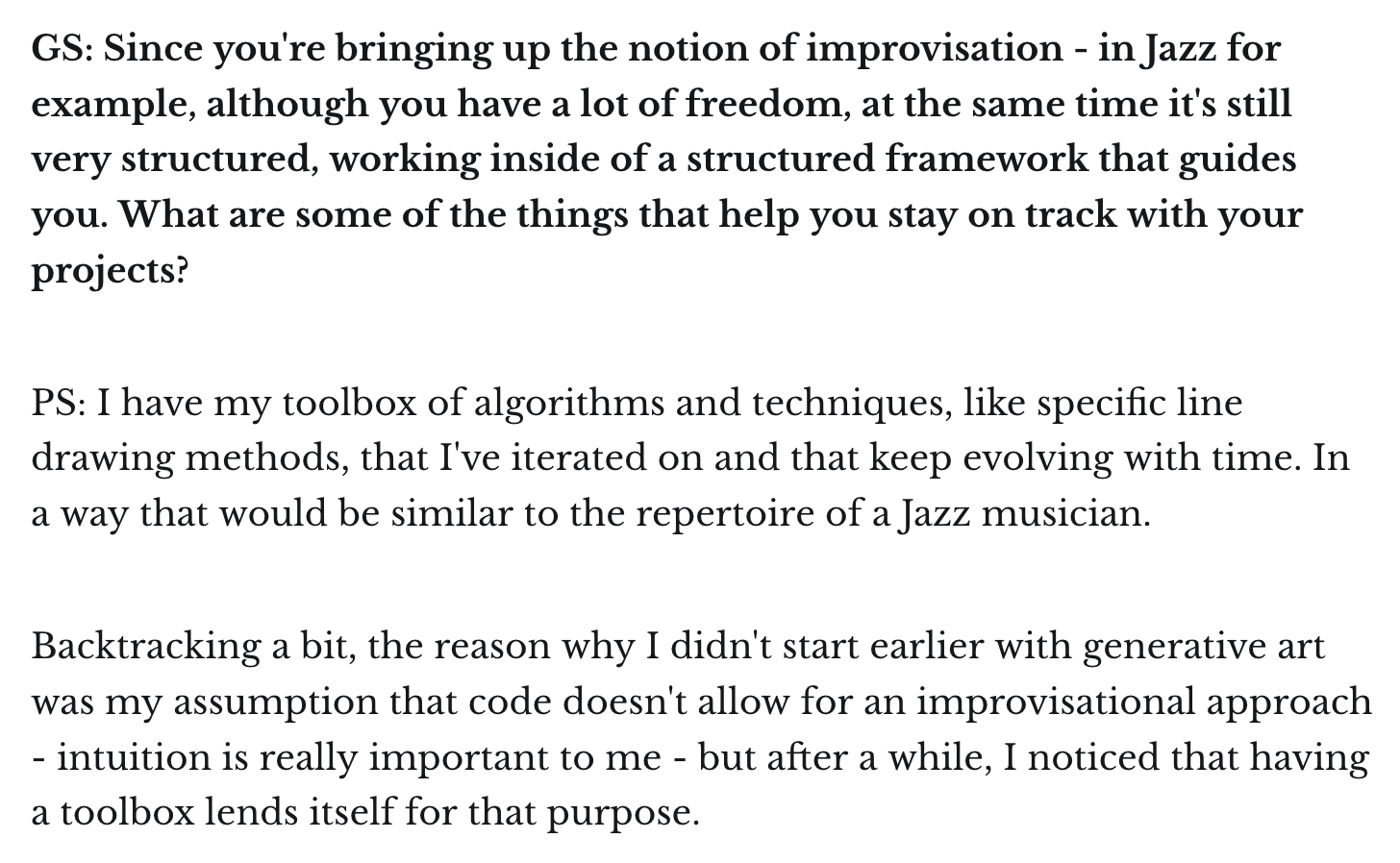
Even if it isn't your goal to do interviews, it's incredibly rewarding to reach out to people, and simply tell them that you're interested in their work - and you'd be surprised how open everyone is to exchange ideas or to simply chat. This kind of "cold" calling is really the best way to make friends on the internet. To everyone that's reached out to me - thank you so much. And if you want to talk to me, simply reach out, I'm always more than happy to do so!
I was also extremely flattered to hear on several occasions that they've enjoyed reading my blog and following along with my generative art. At the same time it makes all of the blog-work so much more worthwhile, by being able to amplify other people's voice and stories through my platform, making the blog feel a little more alive in that manner as well, making it not just my own ideas and words, but also the thoughts of others. Currently, there's two more guest whose interviews will be released early 2024.
Guest Lecture at ZHdK
This one was very exciting but also very nerve-wrecking at the same time. Sadly I don't have any pictures or recordings from the presentation.
Back in mid 2022 I got a message from Josef Renner, a teacher at the Zürcher Hochschule der Künste (ZHdK) asking me if I'd be interested to do a guest lecture for the class that he was teaching. I quickly agreed, because it just seemed like an amazing opportunity to present my work and connect with some new people. I felt very honored and humbled, asking me to present my work and talk a little about the career that I'd carved out for myself. At that point it'd been the first time I was invited to give a lecture.
The difficult part about it: it was in German - I can speak German fluently, but I'm not very confident about it. Moreover, it wasn't just a presentation but a full 2 hour lecture. Although I've done quite a few presentations before, preparing material for a run-time of 120 mins is very challenging.
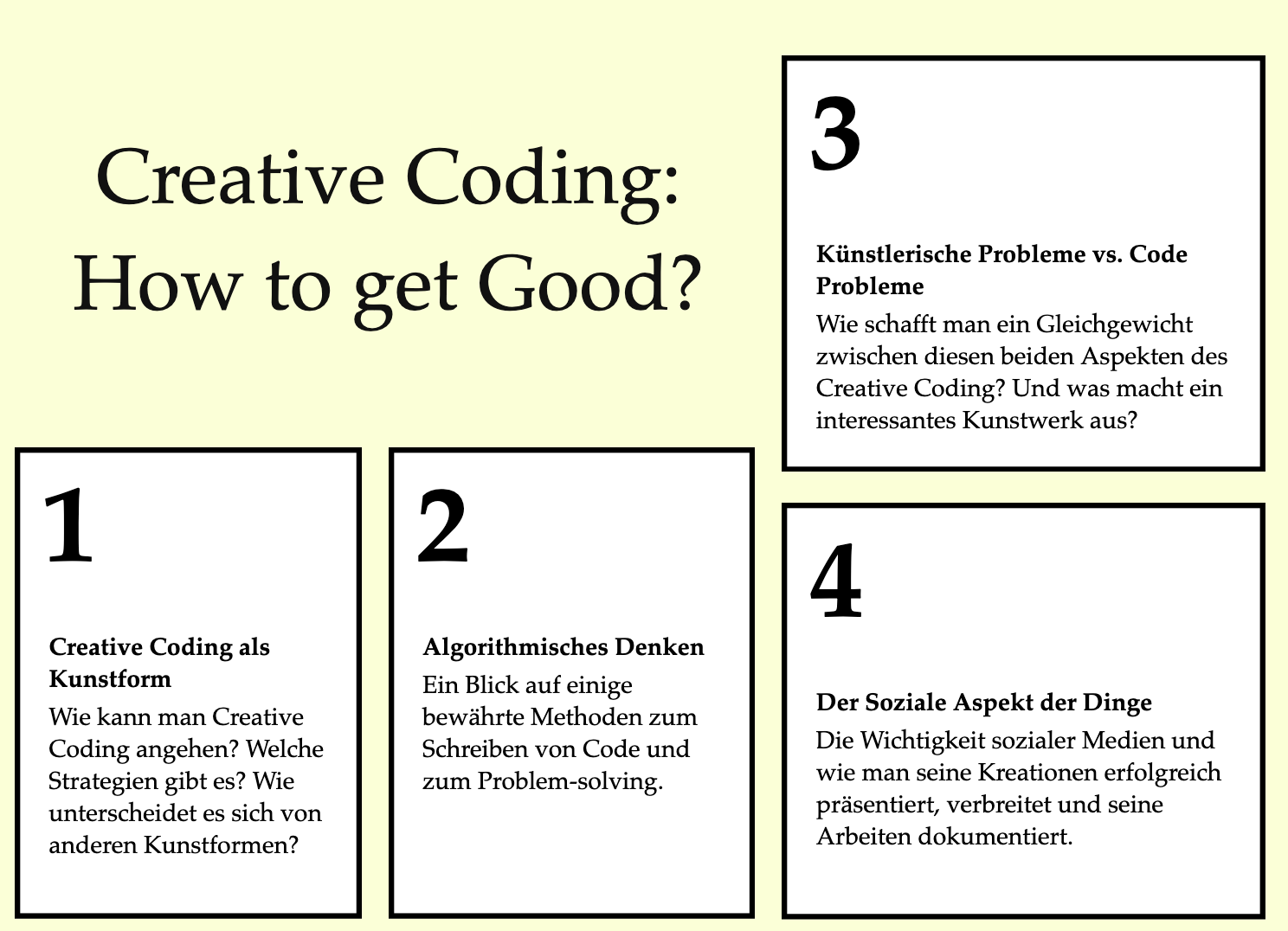
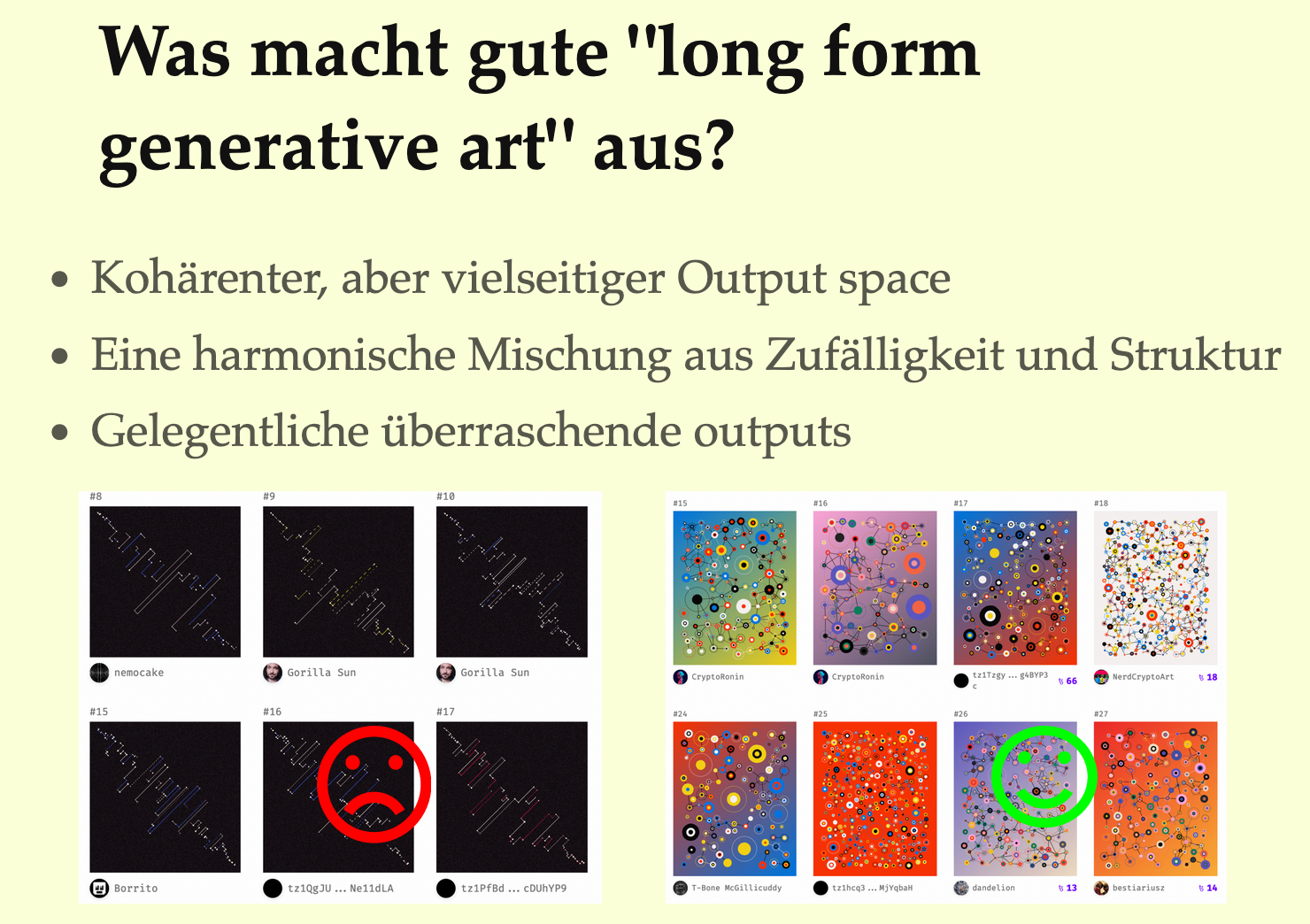
I'll eventually redo the presentation in English and record it at some point.
Josef Renner was incredibly kind to me, meeting me at the entrance of the building, showing me around before taking me to the classroom - the university used to previously be a former dairy factory that had been repurposed - we passed by rooms with students practicing instruments and dance choreographies, and I did feel a little out of place, because I'm just a dude that writes code. But ultimately the presentation went very well.
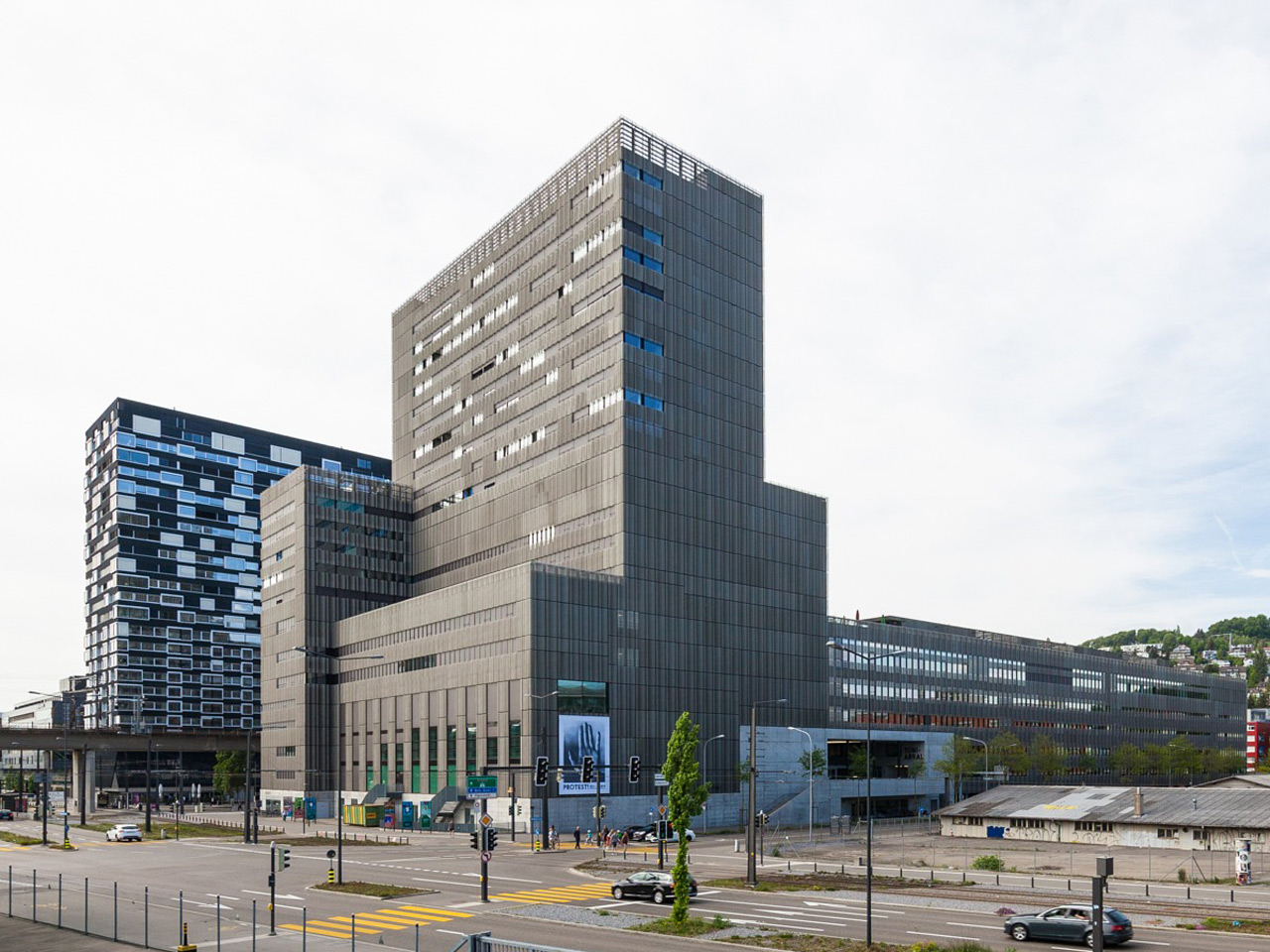
It's one of my best memories of this year, Josef was very kind to invite me for this opportunity.
Raph's Live Stream
It almost feels like it wasn't this year, but Raph and I also did another code review in which we had a closer look at Nat Sarkissian's Eucalyptus and Sagebrush:
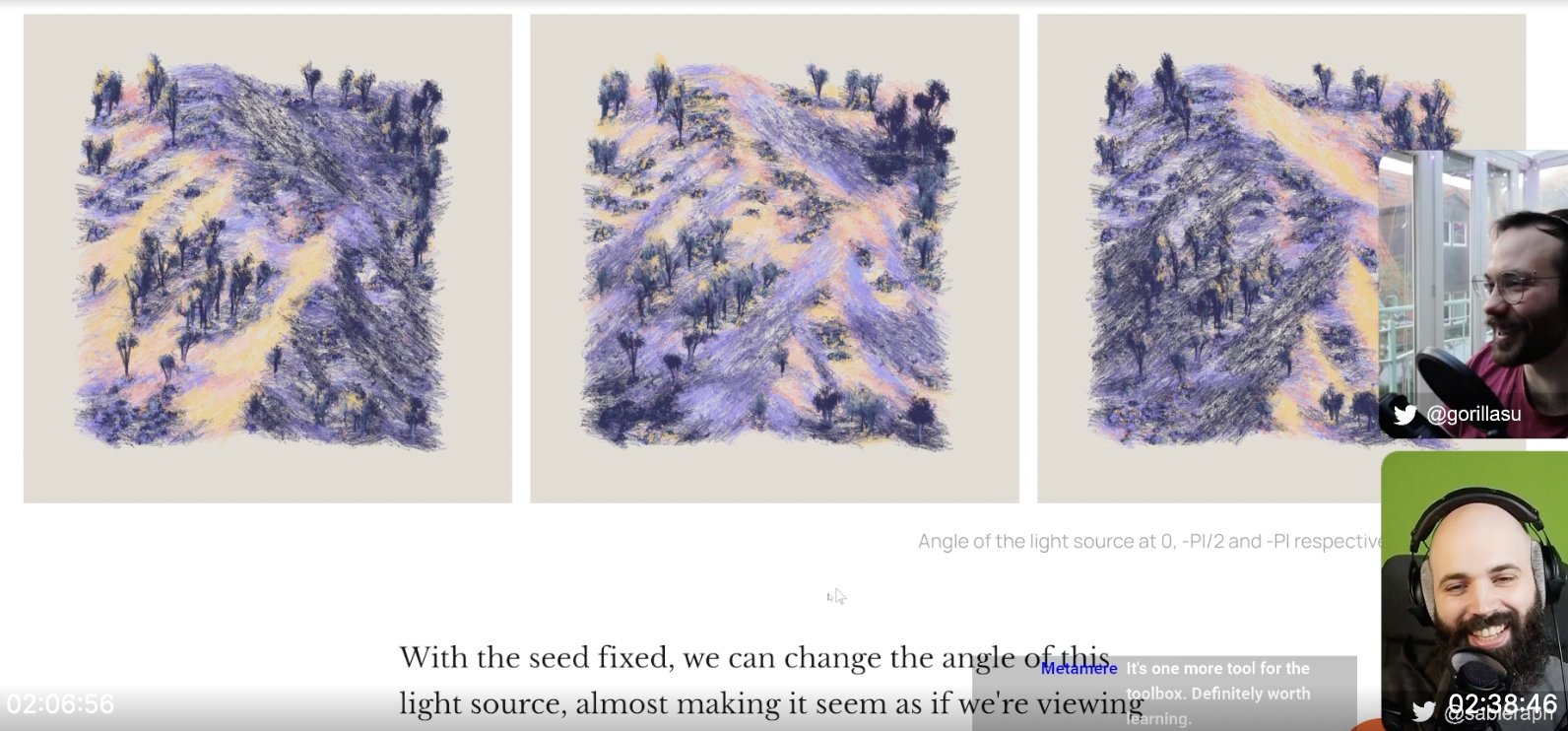
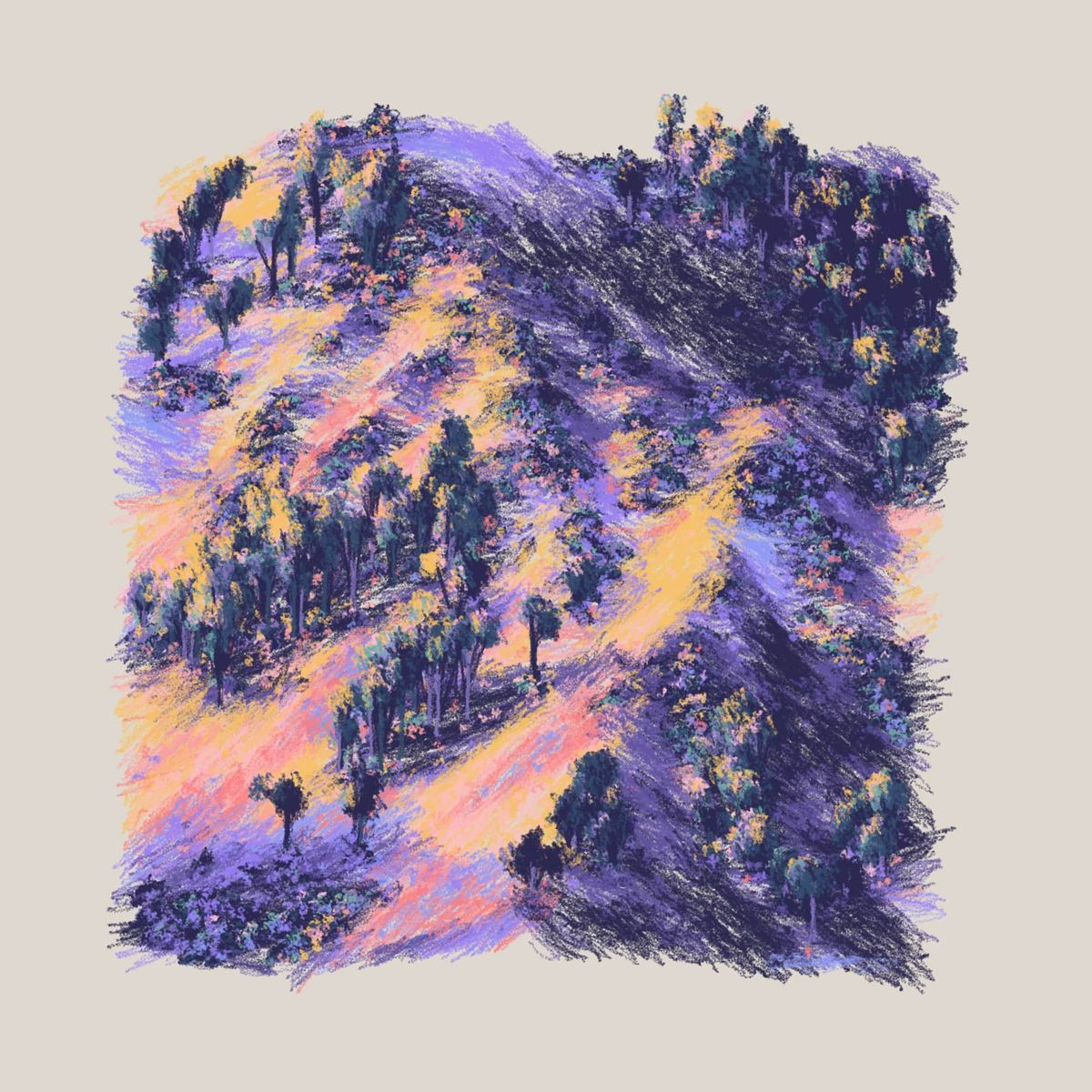
Nat's code was incredibly clean and structured, which lended itself very well for such a review, after getting a hold of him he was also so kind to give us permission to do the review. Procedural terrain generation is an incredibly interesting topic and has been heavily utilised a lot in the context of video games, but can also lend itself well for the purpose of generative art.
It's also been a minute since I've last checked in on the stream, life's been a bit crazy in the past couple of months, so I'm hoping that in the coming year I'll find more time for to participate in the weekly challenge again. On that note, you should check out Raph's Birbsnest discord where you'll find so many lovely people to nerd out about creative coding, among other things.
DiGen Art Gallery in Lebanon
Back in August I got a message on Twitter asking me if I'd like to create a piece for an upcoming gallery in Lebanon, and I really didn't have to think twice about it. That's how I got to know Alex and Camille, the two brains behind DiGen Art, a gallery with the mission to bring digital art closer to the MENA region.
After they'd seen my little timelapse that I'd done for Genuary, they thought that it was a really good way to convey what creative coding is really about and wanted to showcase a similar piece on the DiGen homepage.
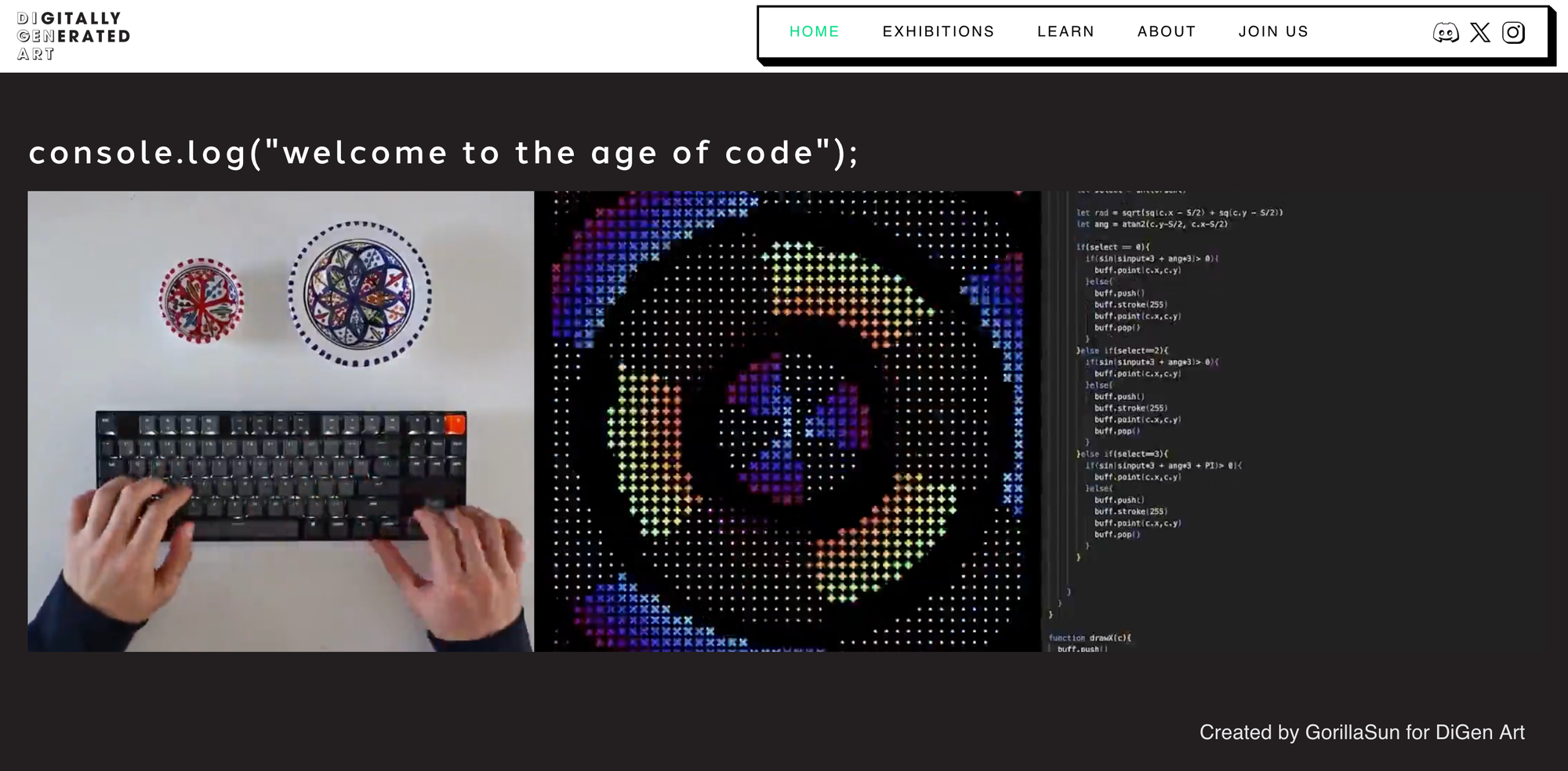
I quickly got to the drawing board and after a couple of initial ideas, I thought it'd be best to create something in the same vein of the Genuary animation - a rotating SDF that included some aspects of the brand book that they shared with me, mainly their brand colors as well as the reoccurring arrow symbol.
The final DiGen Animation
Recording my hands as well as the code in sync proved to be quite challenging, and there's a also a certain choreography to how the code builds up to the final animation which is not very easy to do. It was genuinely a really fun project to work on and I'm hoping to collaborate more with them in early 2024. You should check them out over on Insta, they're recently had their soft-launch and made some ripples in the local news:
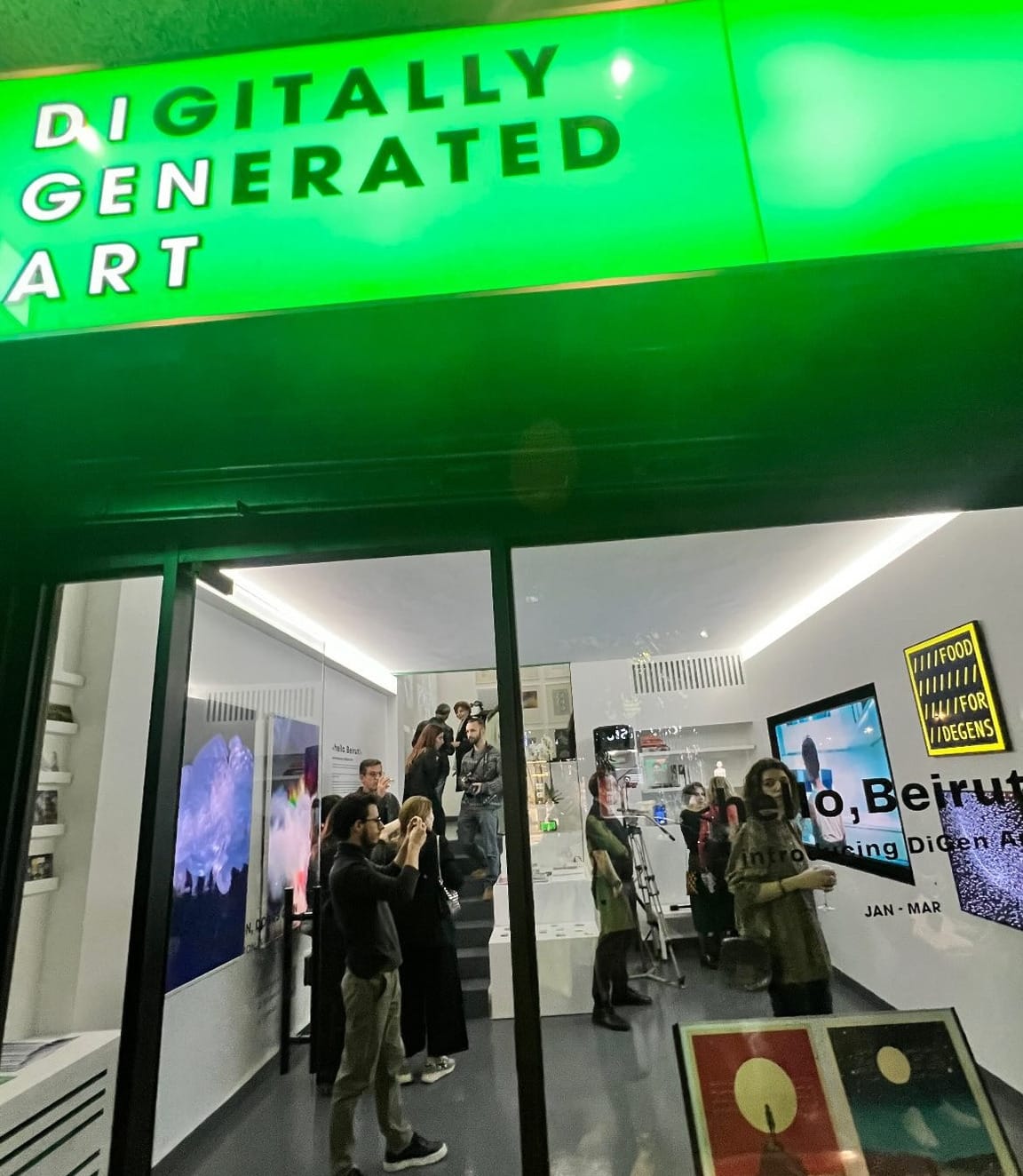

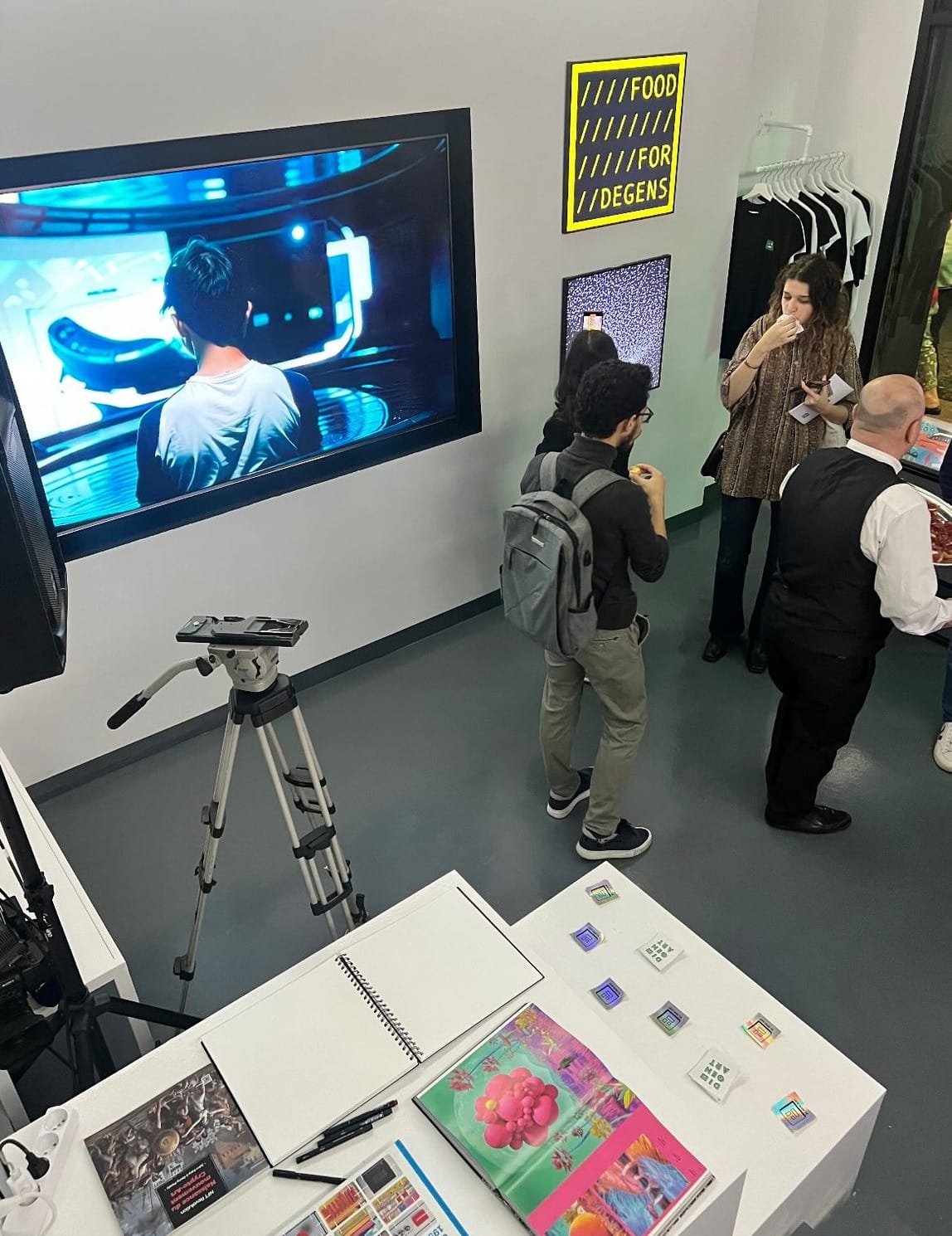
Their gallery is in the vicinity of AUB where I did my bachelor studies, located in the area that I grew up in and spent most of my childhood.
Helping out with the fxhash Docs
The last big project to conclude 2023, which I loved being involved in: helping out with the revamp of the fxhash docs leading up to the 2.0 release. It was also quite a challenging task, the writing per se not being the most difficult part, but rather the structuring and presentation of the concepts and notions that fxhash builds upon in a logical and chronological manner. For someone who doesn't know the first thing about blockchains, NFTs and generative art, there's so many things that need to be explained prior to getting into the nitty gritty.
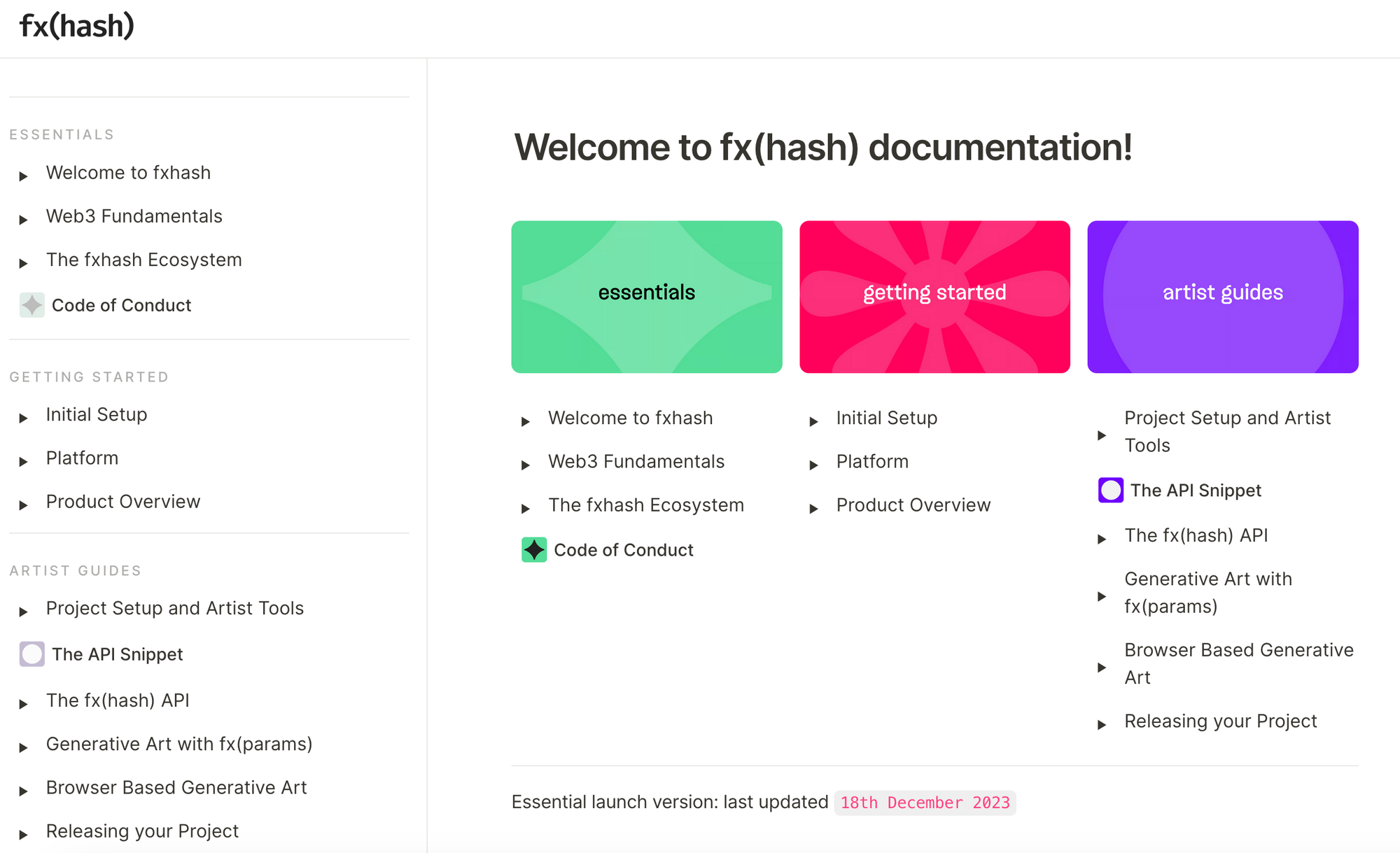
Because fxhash has evolved so quickly over the span of two years, with a truckload of features having been added, there were a lot of things in the docs that needed to be further elaborated on as well as shuffled around. At this point there's still a few things that need to be added, related to the new Ethereum integration that introduced many new functionalities to the platform.
And especially when it comes to the tools that fxhash makes available to the artists for building different kinds of tokens, there's so many things to keep track of, like the directory structure of a project, how to use randomness within your code to ensure deterministic behaviour, how to test a project in fx(lens), how to make a responsive generative artwork in the browser, etc. It's a very involved undertaking, and hopefully the docs can be of assistance in that regard to everyone who's starting out on fxhash.
It was also very insightful and educative for my own sake being able to do this deep dive - I now feel much more confident going into building my own tokens.
Lessons Learned
Probably the biggest lesson I learned about myself throughout 2023 is that I want to make art, a lot of it actually - but don't necessarily want to be a full-time artist. I also want to be known as the guy that writes awesome articles about generative art and creative coding. Here's some of the tips I've picked up along the way and that I'd give to others
- Always have some projects at the ready, that you can quickly turn into finished works. You never know, the next stellar offer might be just around the bend.
- Work ahead of time and archive things. Sounds obvious, but especially with the Newsletter for instance, collecting interesting finds throughout the week is crucial, you can't leave it until the day before, because so many cool things will have vanished within the maws of the social media machine.
- Reach out and talk to people. Even though the generative art thing exists to 90% online and in the social media bubble, networking is absolutely still a thing. Join a couple of chat groups, try to be active, talk to people, make friends and have fun.
- Make your own website if you don't have one already. It's literally free real estate on the internet. Create a footprint and try to make that footprint as large of as possible. Be loud.
- Document your work. People do read. It will come in handy when you're asked to give a talk, presentation or workshop. You'll have that information at the ready and just need to turn it into slide format.
- Shoutout and support other people's work - it doesn't cost you anything to leave a like or to repost something, but it can have a big impact on the receiving person's end. When Bjørn Staal gave me a shoutout in one of his threads, I gained like 200 followers overnight, and that was massive. So thanks for that, Bjørn.
- Stop being hypercritical of your own work. A particular project might suck, another one might be stellar, the important thing is that you learn from what works and what doesn't and try to refine your process, it's impossible to not get better with time if you keep churning out new works.
- There often is no relation between the quality of your work and selling out. And you should absolutely not let it affect your mental health, moreover your self-worth is not tied to selling out. Make art for the joy of making art, for yourself, and be grateful for those that do collect your work and support you. No one owes you anything.
- Credits for this one go to Frederik Vanhoutte and Joshua Davis, two artists that I admire: "Make the work that you want to be known for. Don't get trapped in making formula pieces because that's what you think will be popular."
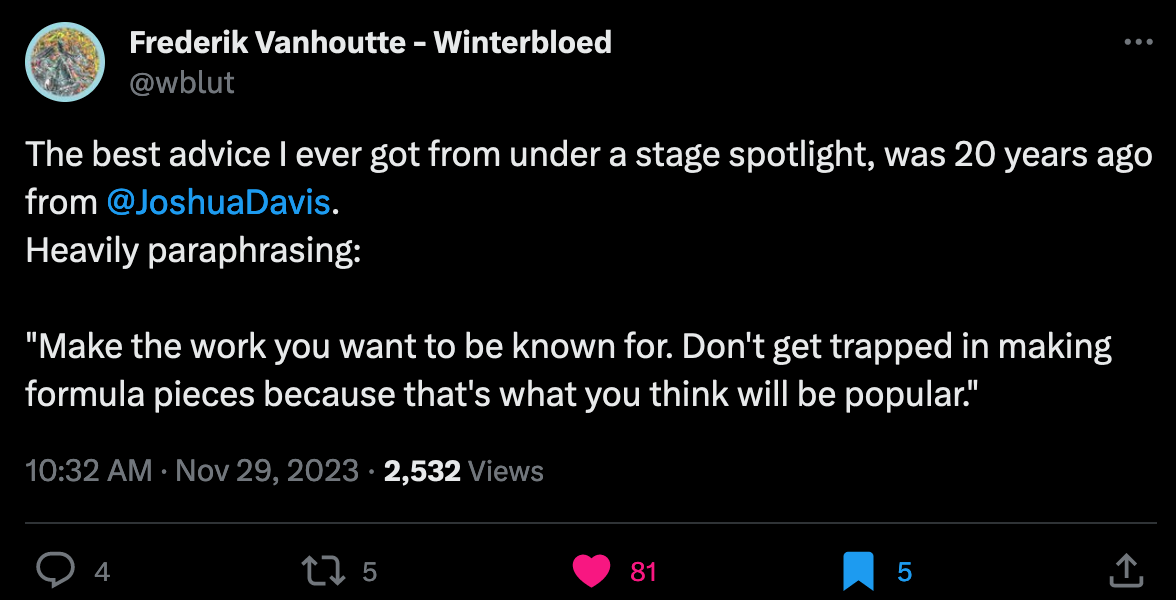
Thank You
I can say with certainty that this has definitely been one of the more challenging years of my life, and there's been quite a few rough patches throughout 2023. With times being as turbulent as they are, with social media platforms in a constant state of upheaval, with fears of AI changing the entirety of the internet landscape it hasn't been easy to create work under these circumstances. But I think that it's only normal to have worries and to sometimes struggle with reconciling an online presence with real life, and to manage the two in parallel.
The older I get, the more I feel that I'm getting a better grip on all of these things though, and looking back it feels like I've come such a long way already. I've grown as a person, emotionally and professionally. Moreover, I'm healthy and alive, and so are my loved ones, and that's all that really matters at the end of the day.
Moreover, I get to do this really amazing thing and share it with you all. It goes without saying that the blog only comes to life through it's readership - again a big thank you for reading these words. Thanks for sticking around and supporting me, it genuinely means a lot to me.
I find myself at a point again where there's way too many people that I'd like to thank. First off, my beautiful partner for supporting me, always pushing me to better myself, being my crutch in those moments when I find myself wanting to burn everything down to the ground, pushing me to keep going and not give up.
I'd also like to thank all of my internet friends. Anna, who's always first to share the newsletter whenever it comes out on Mondays, and for being so supportive of so many artists in the space.
Peter Bauman and thefunnyguys from Le Random for enriching the generative art space with their editorial efforts and supporting the newsletter.
Raph for having trust enough in me to bring me on his show, in 2022 and again in 2023, it takes a lot of effort and dedication to do the long live streams that he does and I admire him for it, I certainly couldn't do it. Thanks for being a cool dude in general and for fostering the lovely birbsnest community. Also big thanks to Dave for always being the first to aid whenever someone's in need over in the help channel.
Thanks again to the all the guests that have agreed to be interviewed on the blog Tezumie, Peter Bauman, Pxlshrd, Alessandro Fiore, as well as Daniel Aguilar, and Ryan Murdock whose interviews will be released early 2024.
Thanks to Alex and Camille from DiGen for reaching out to me and letting me make their website banner.
Thanks to everyone who's collected one of my generative artworks on the blockchain. Everyone that's given me a shout. Everyone that's subscribed to the Newsletter. Every follower on every platform that I'm on. Everyone that's reading this.
I wish you all much love and happiness and an amazing start into the next year! Cheers, and see you in the next one - Gorilla Sun 🌸
